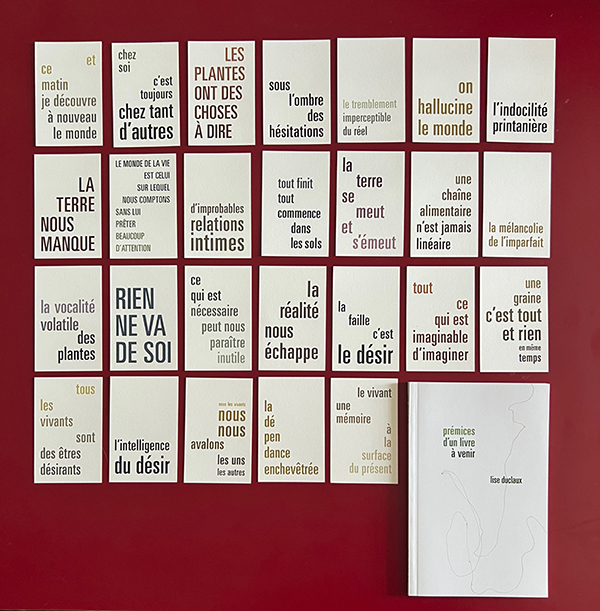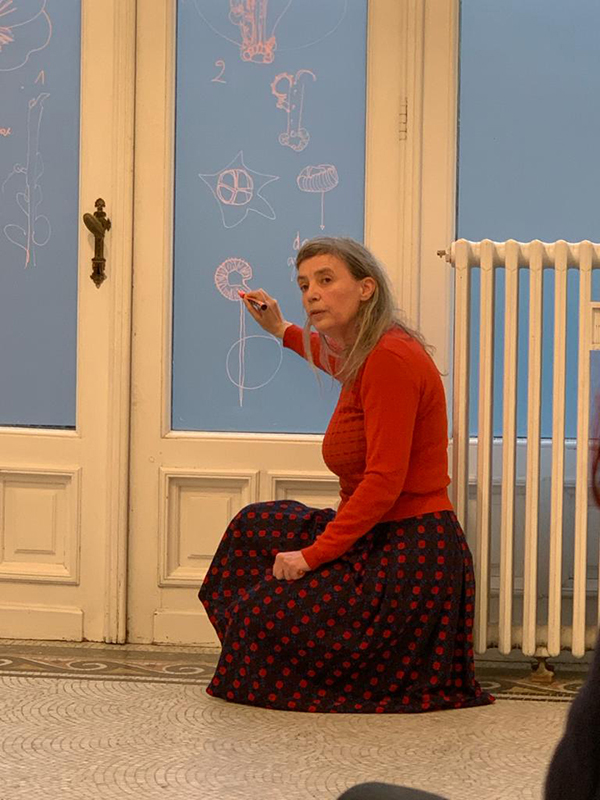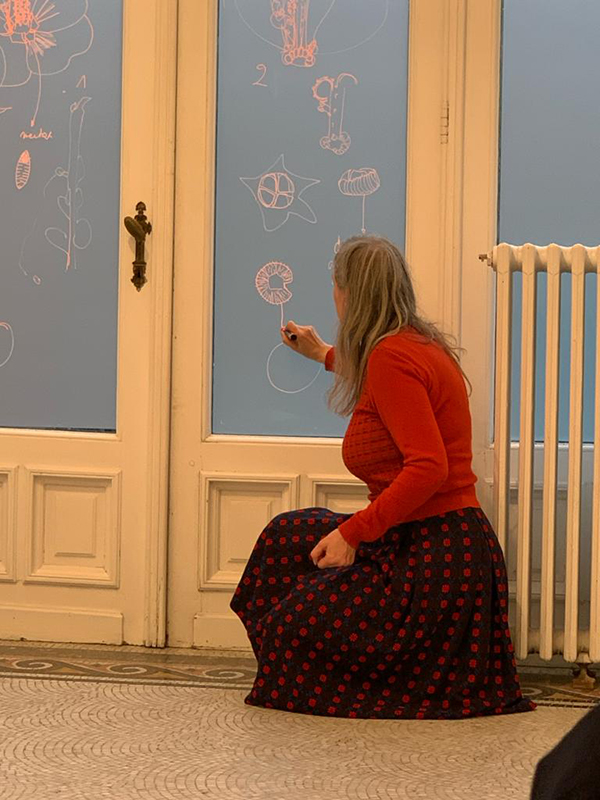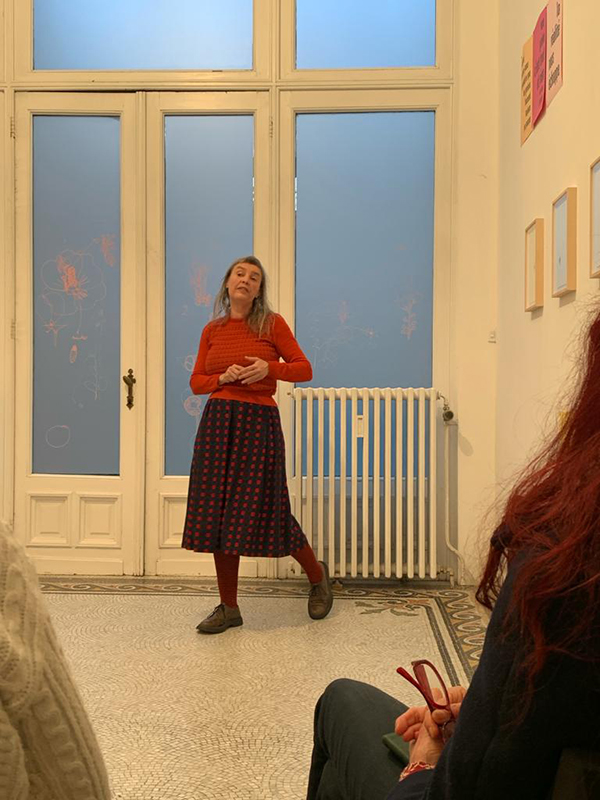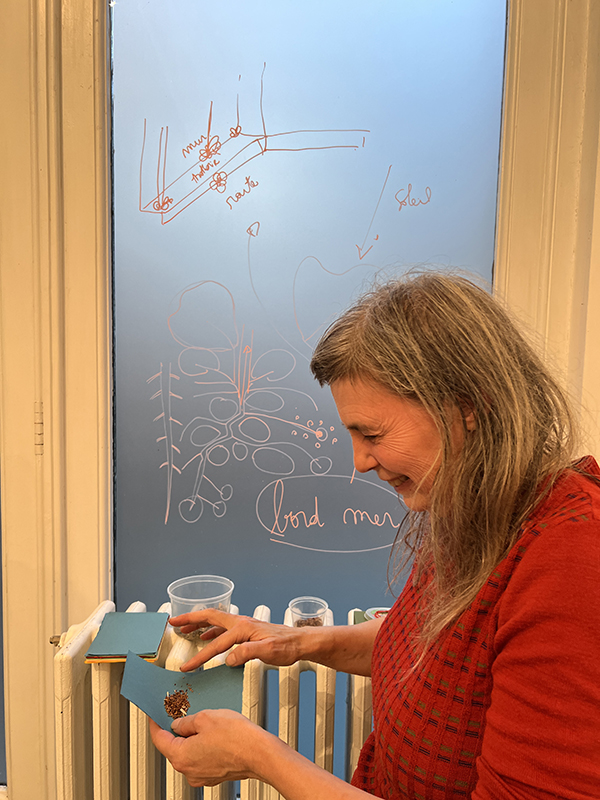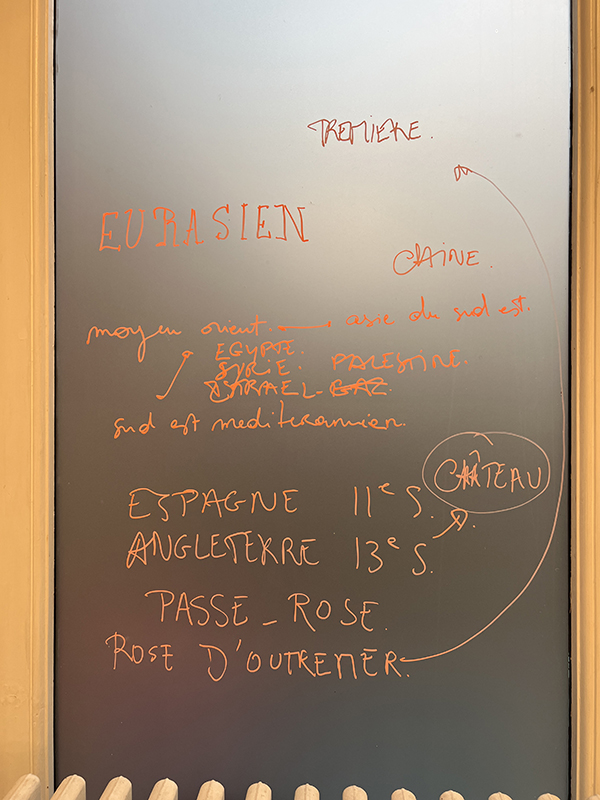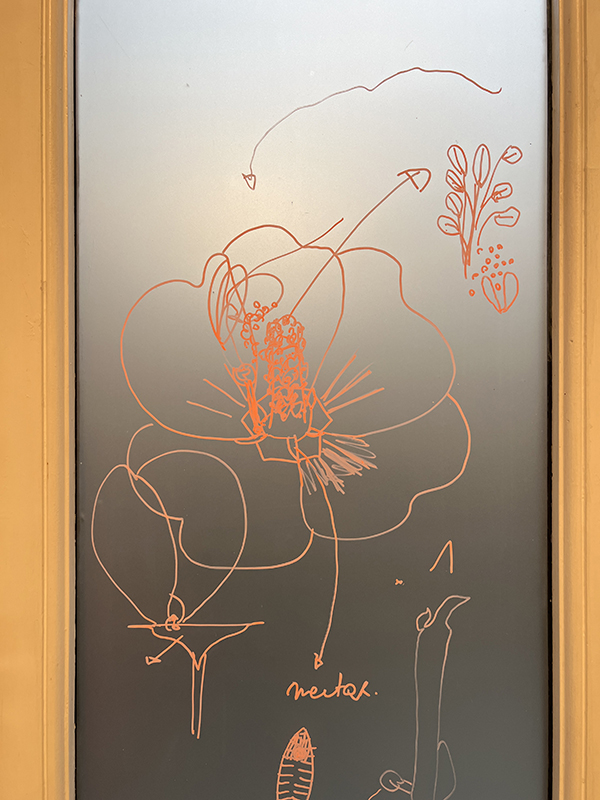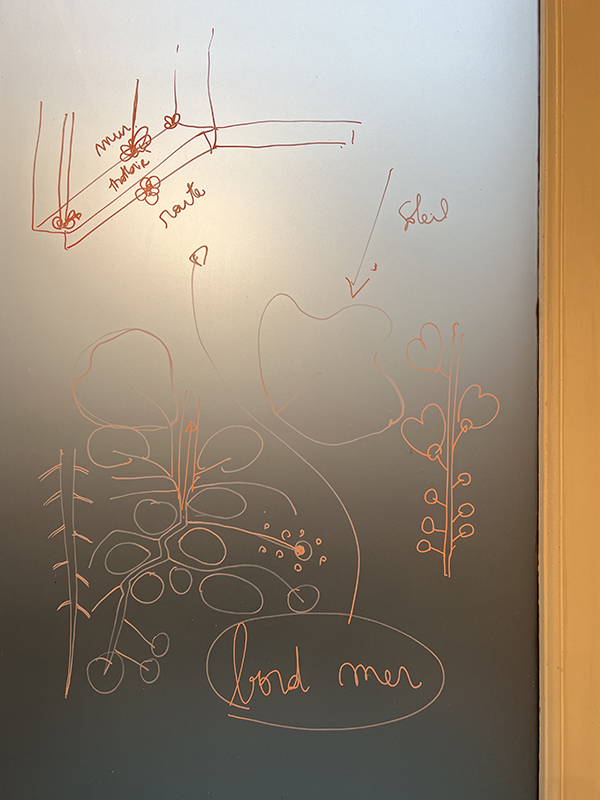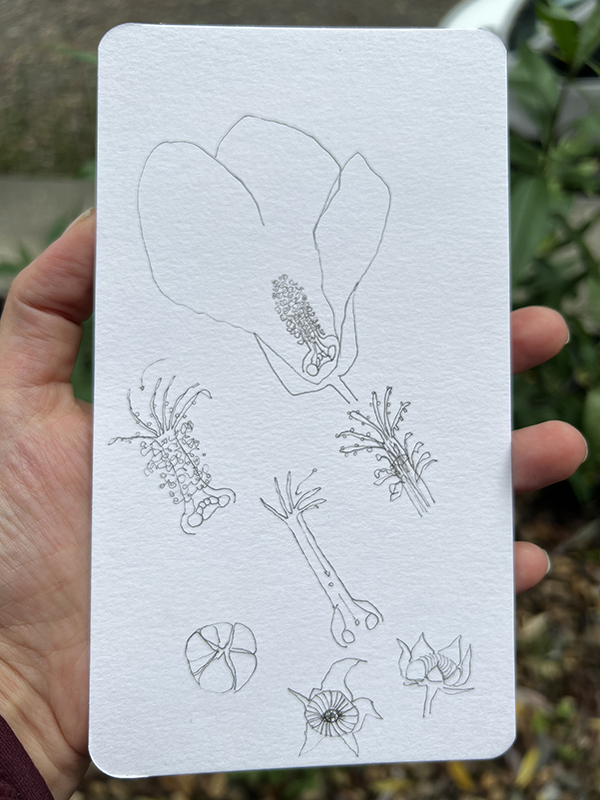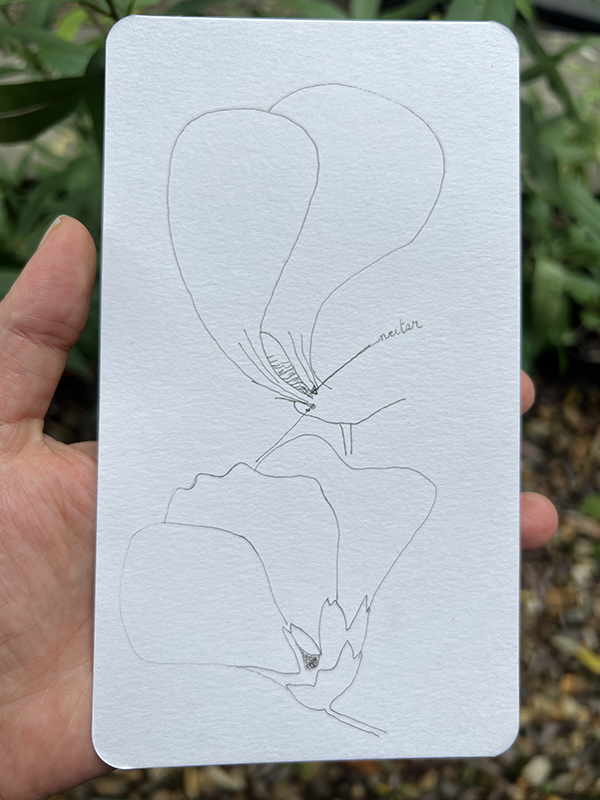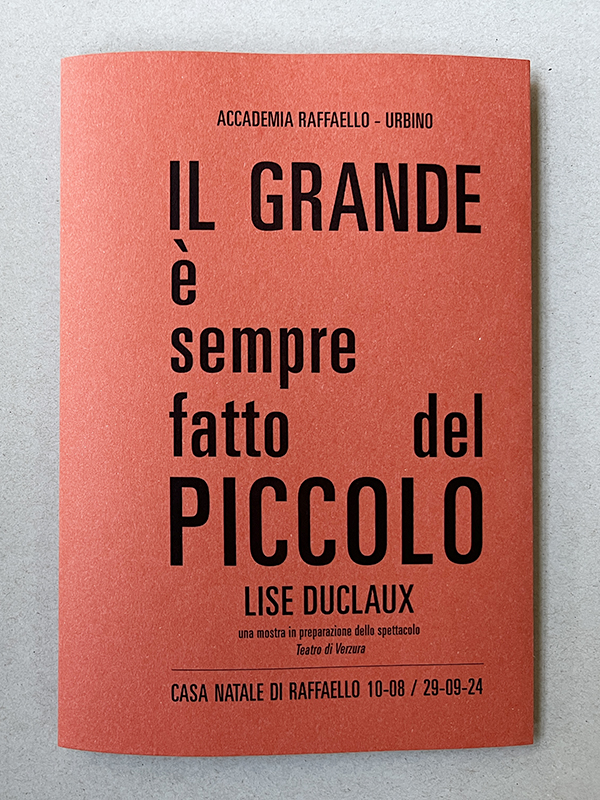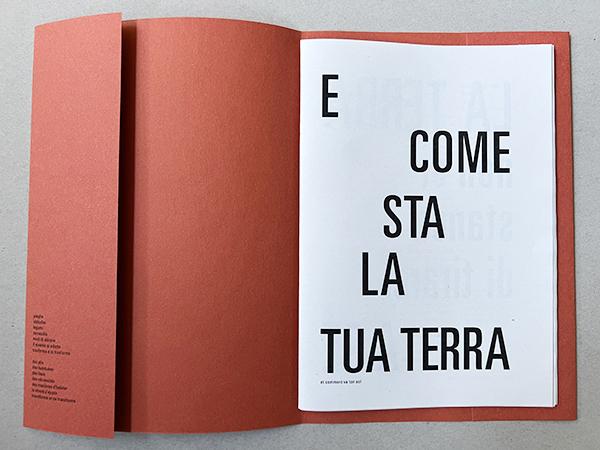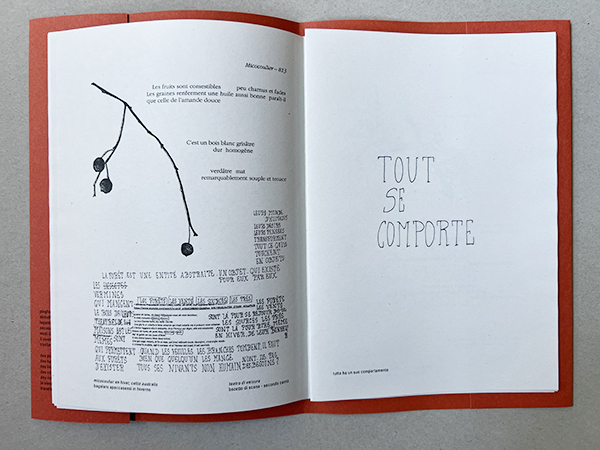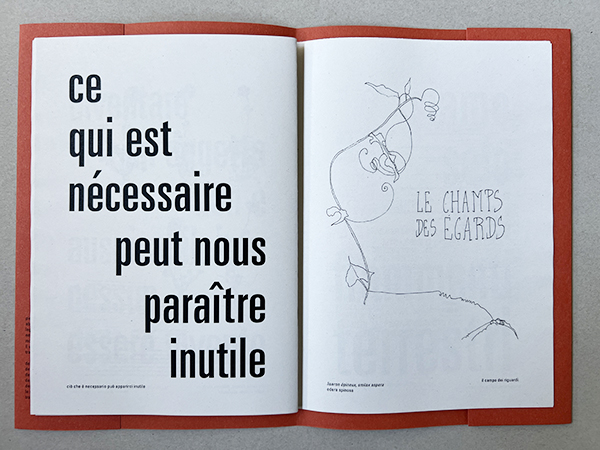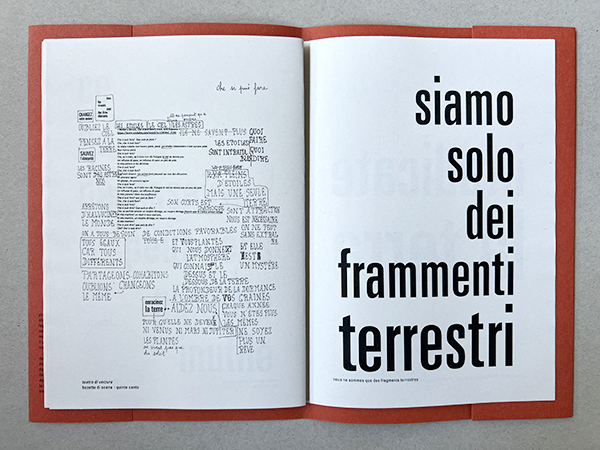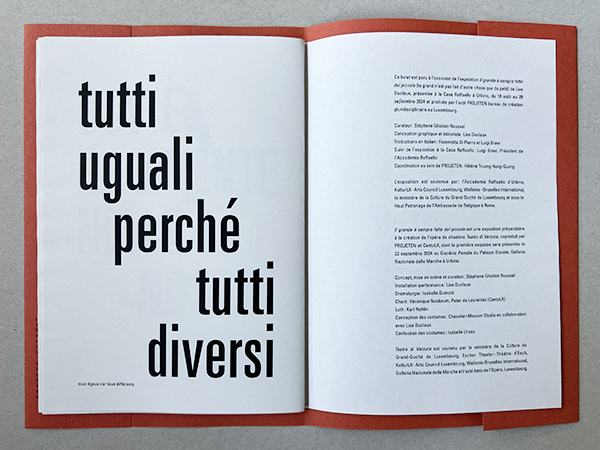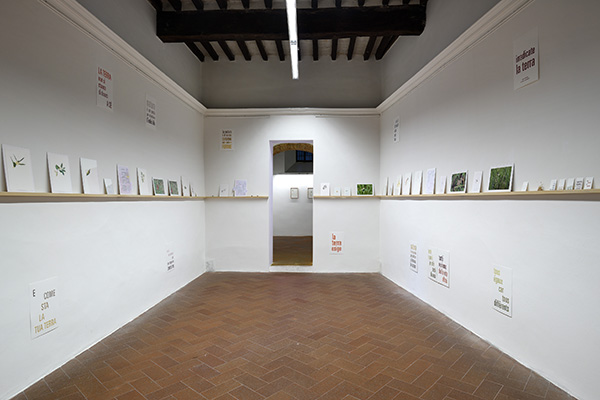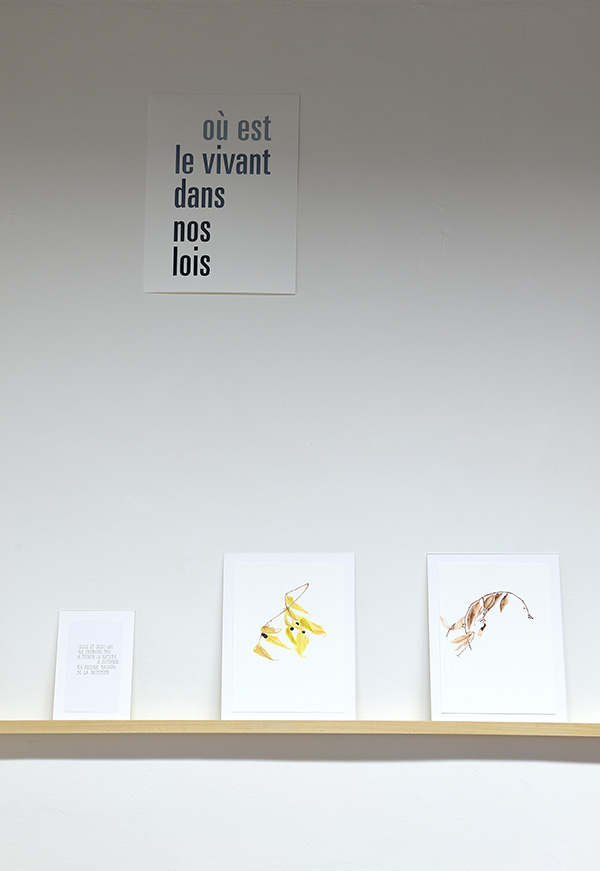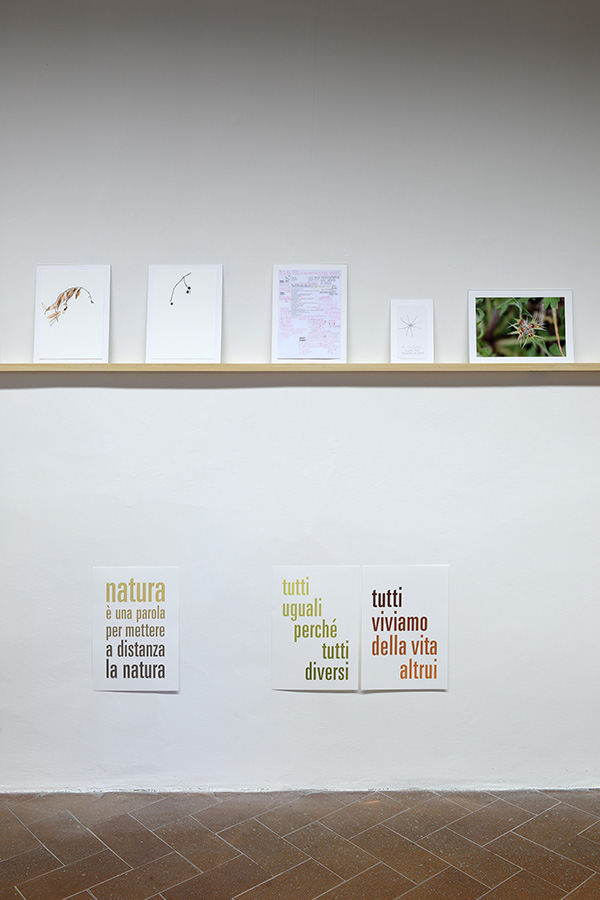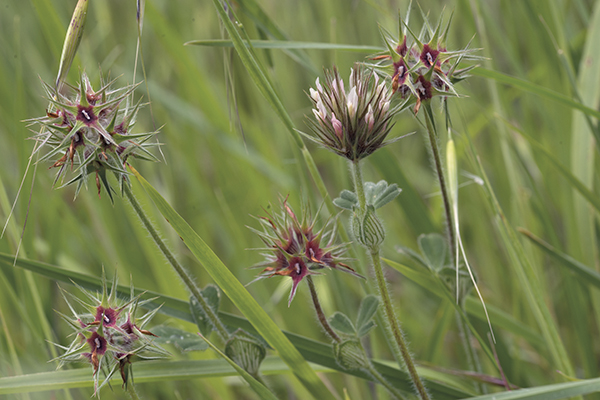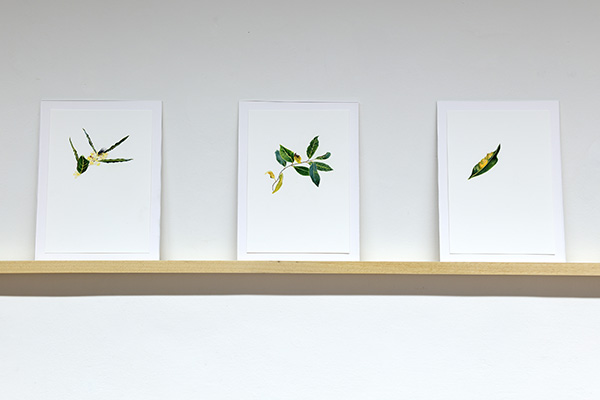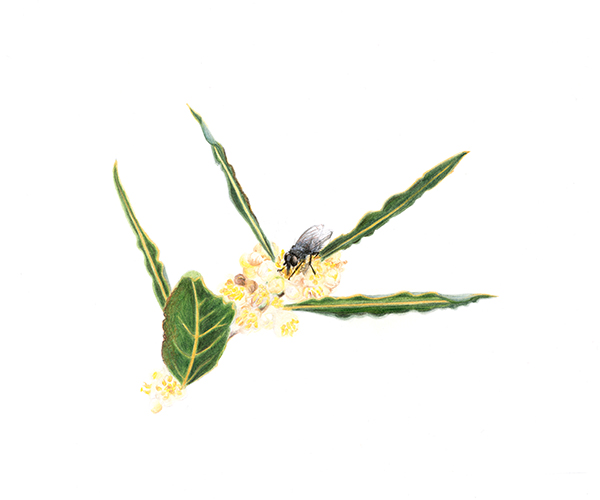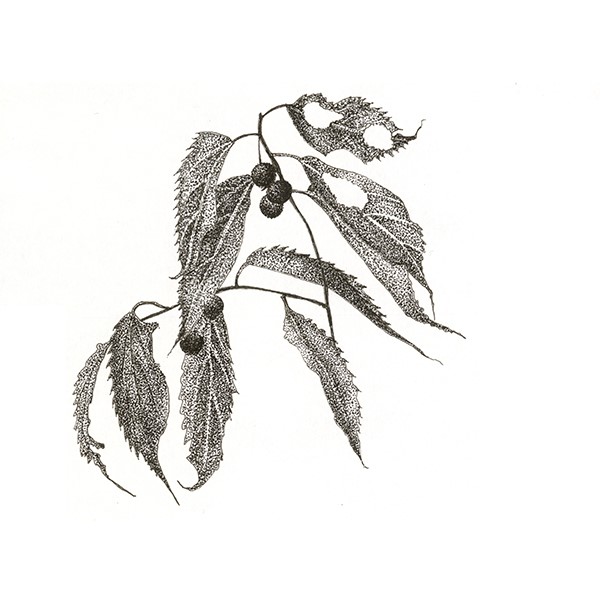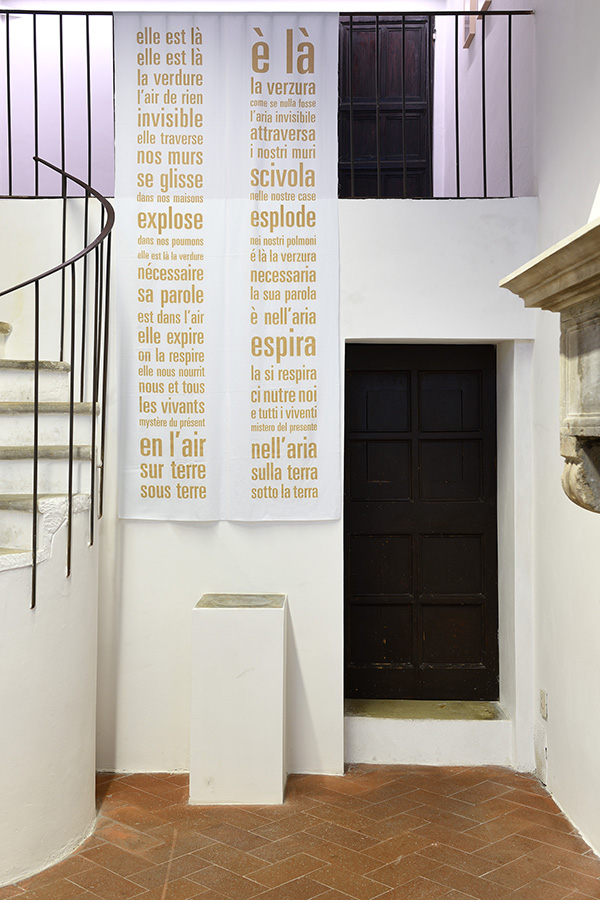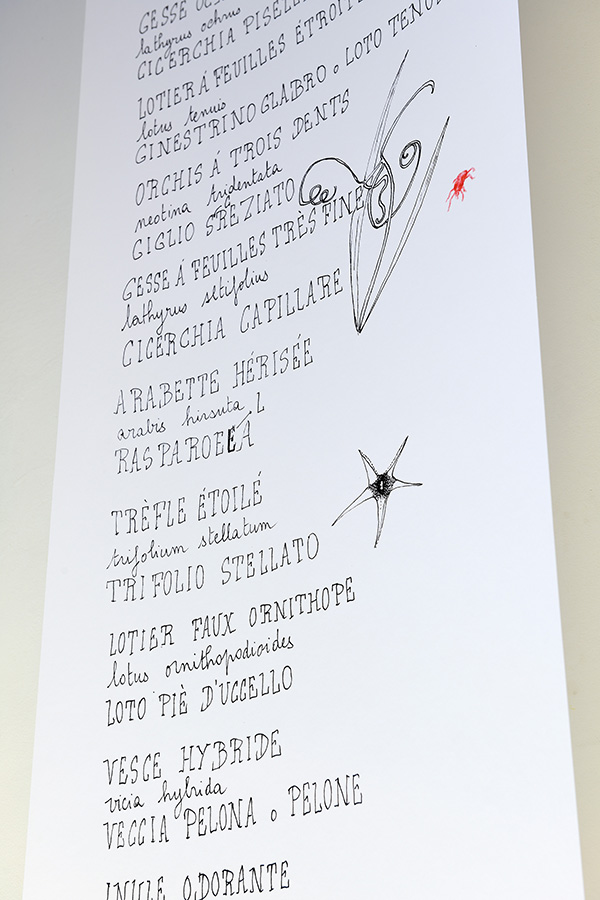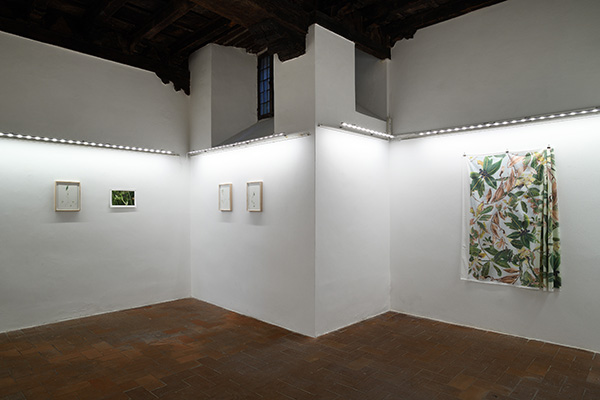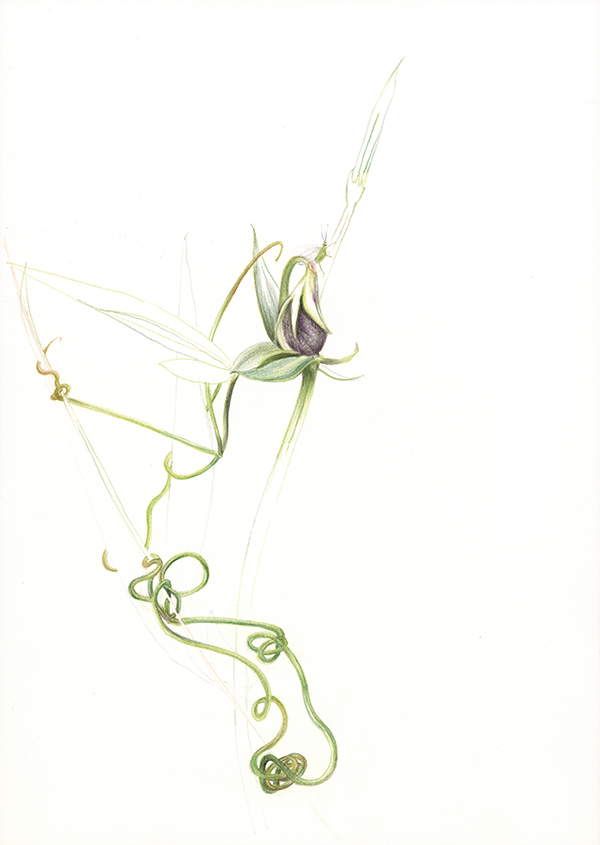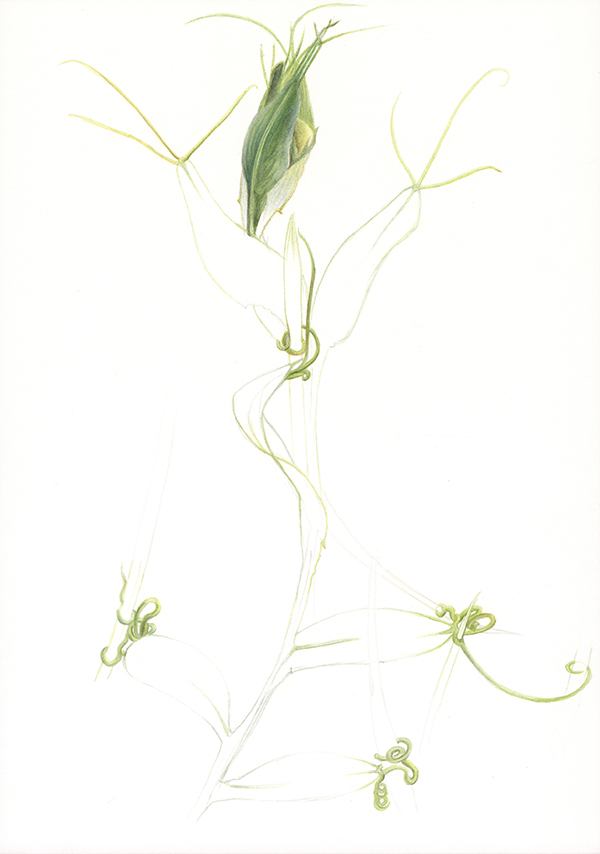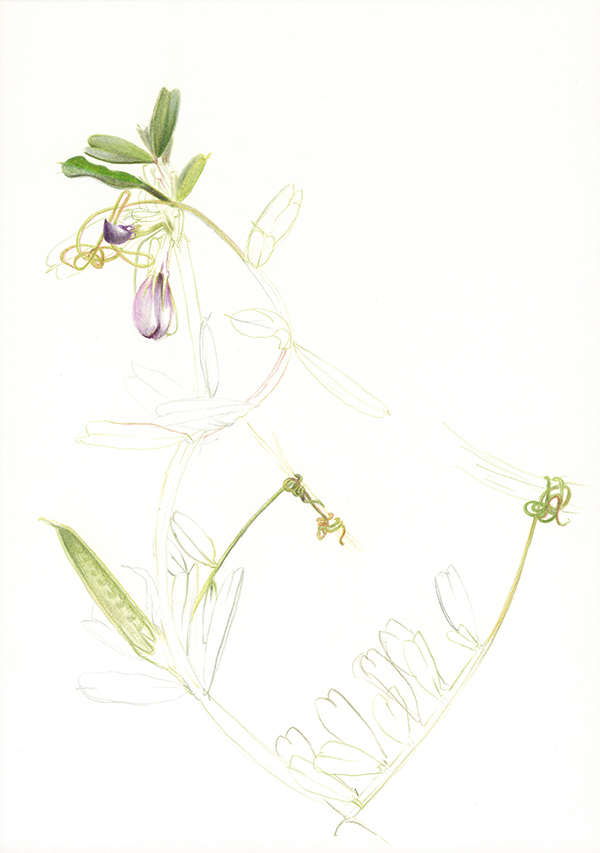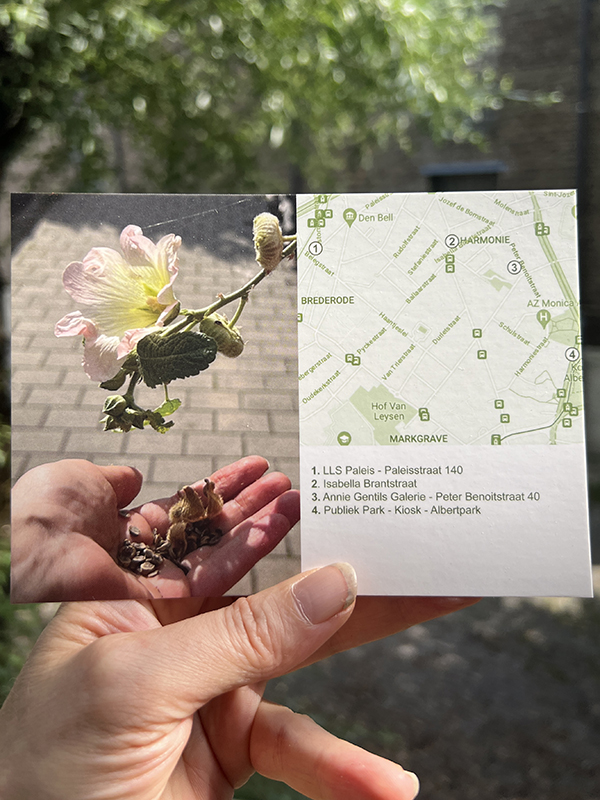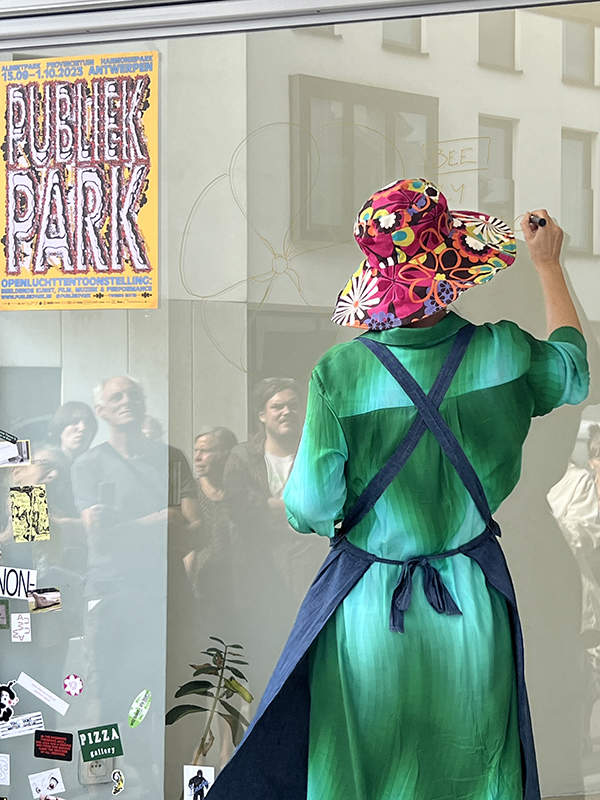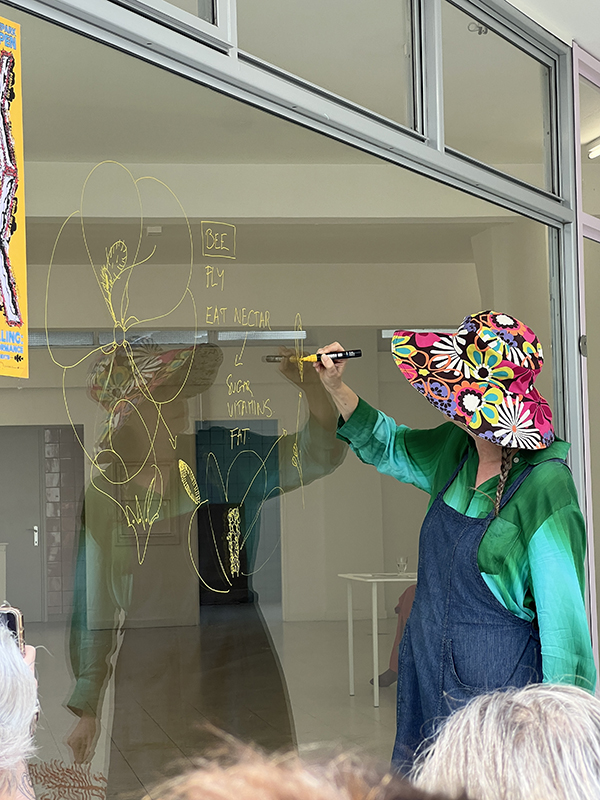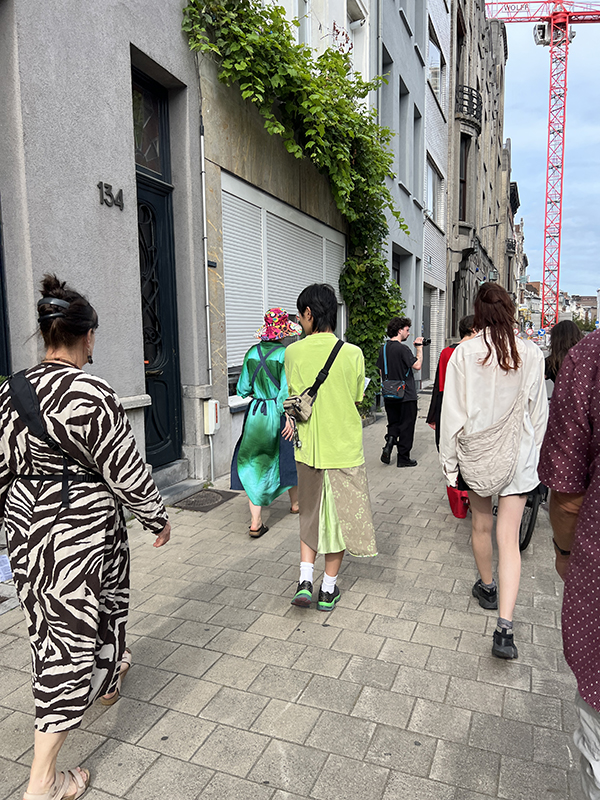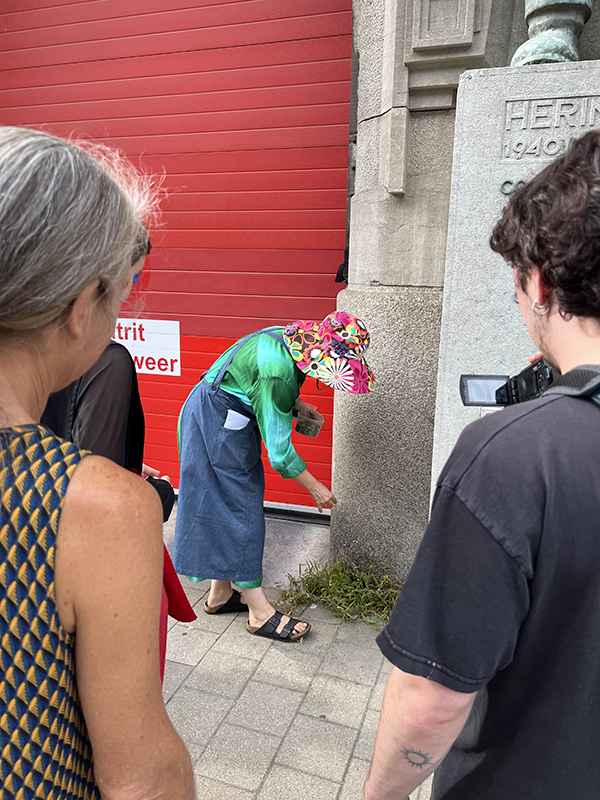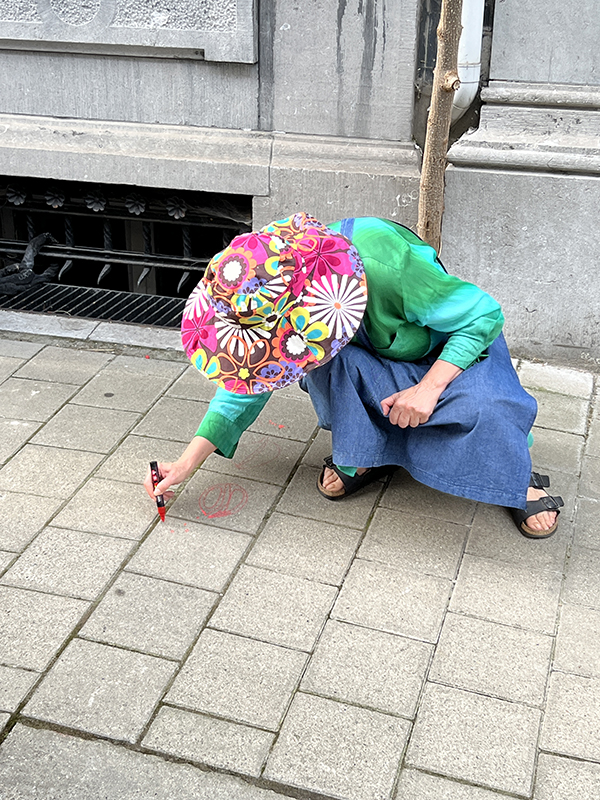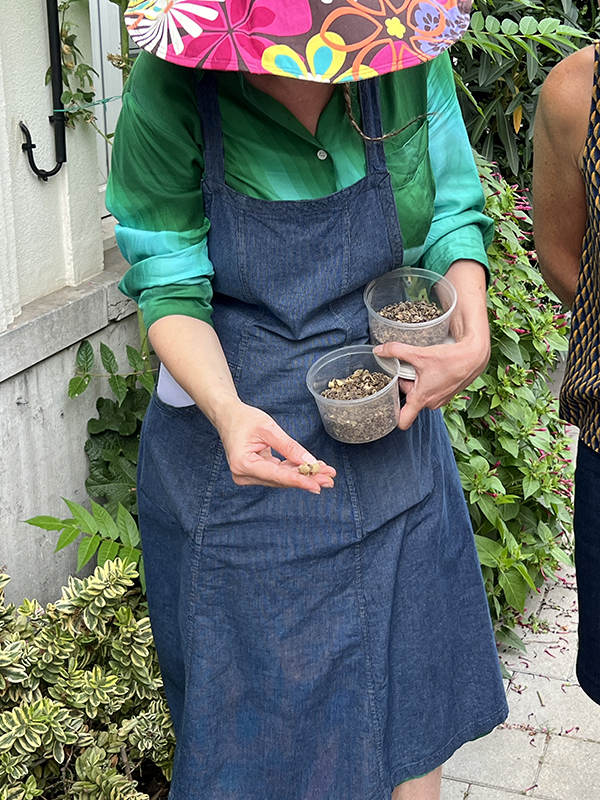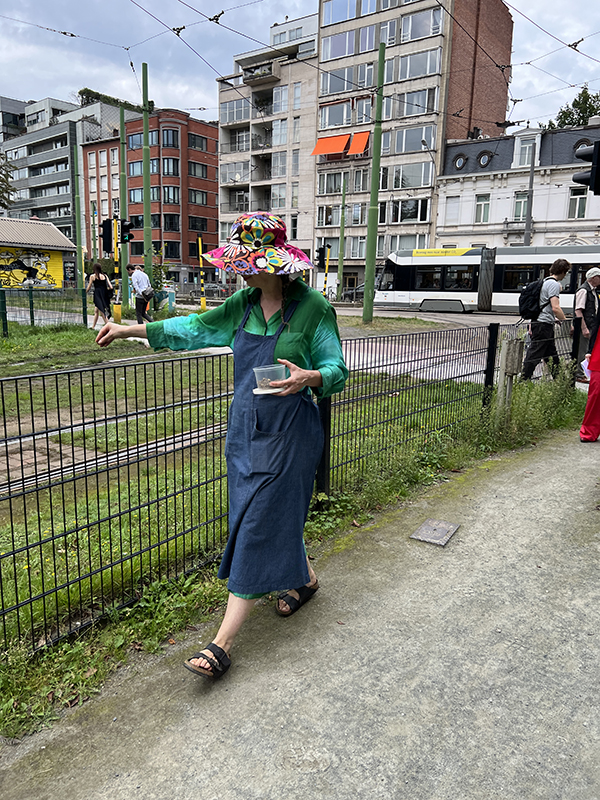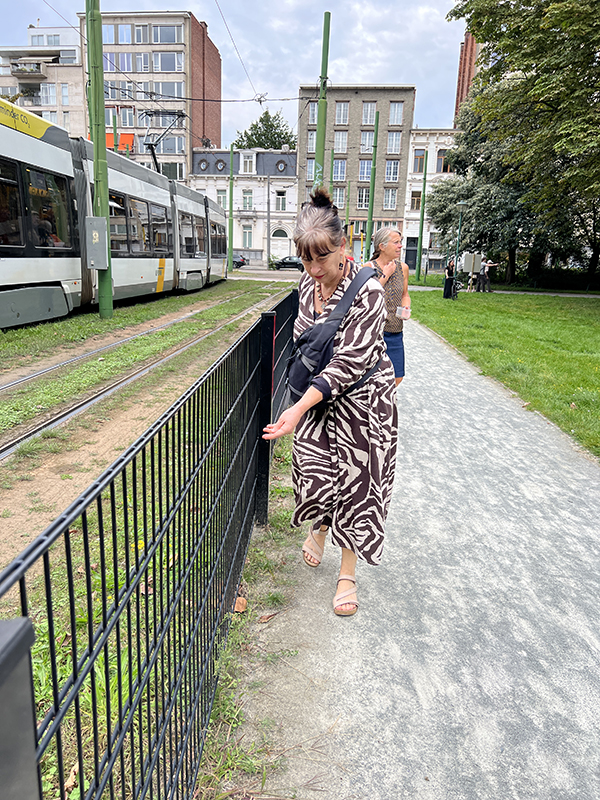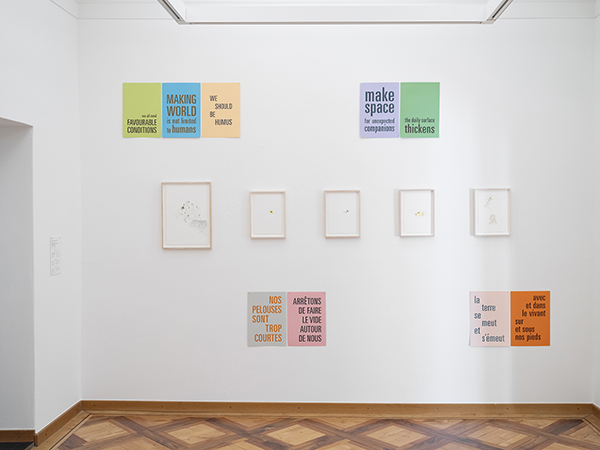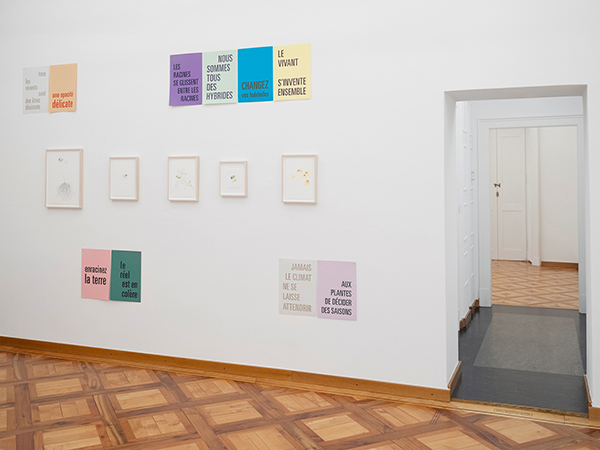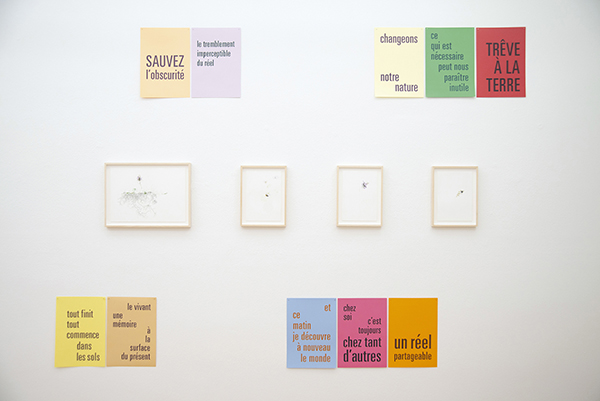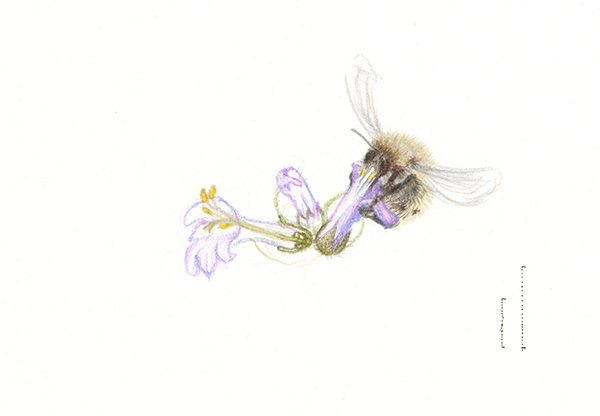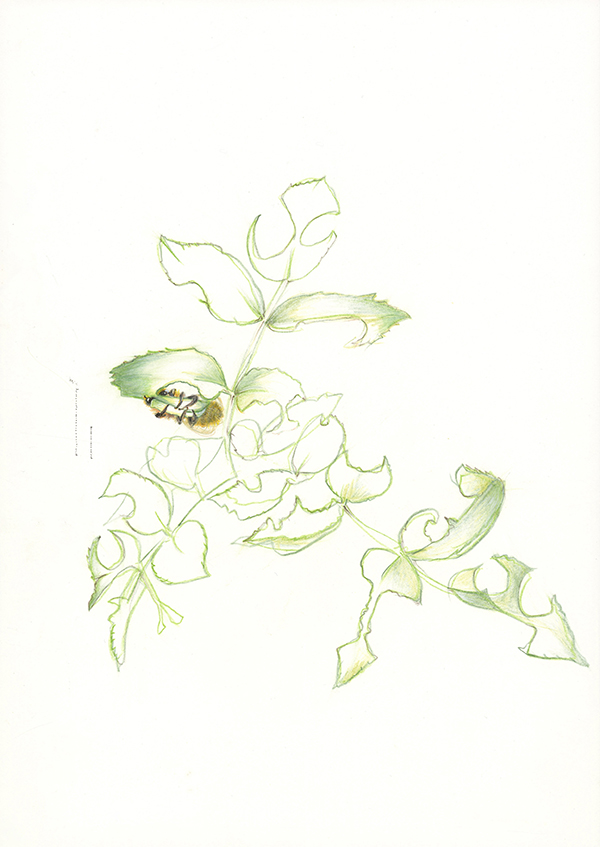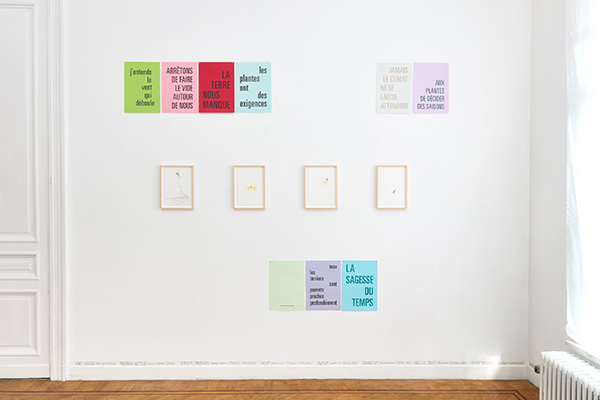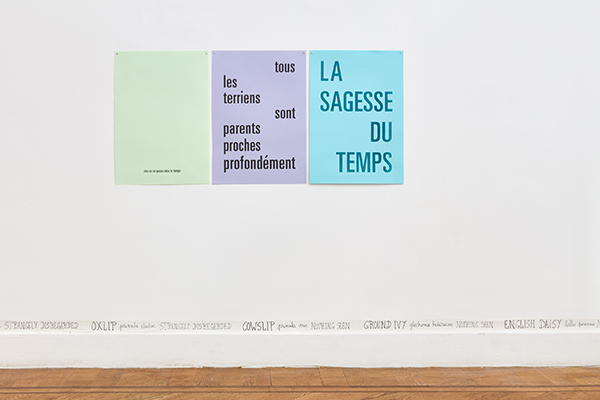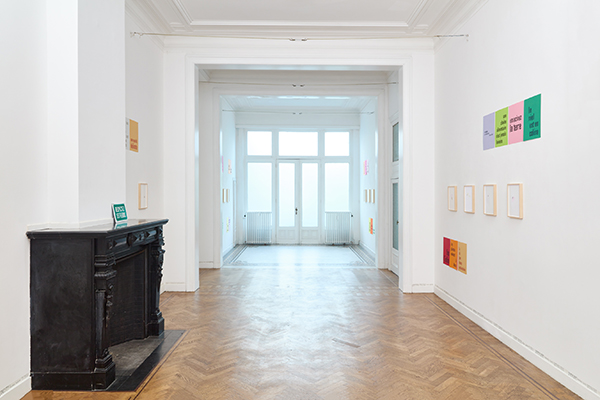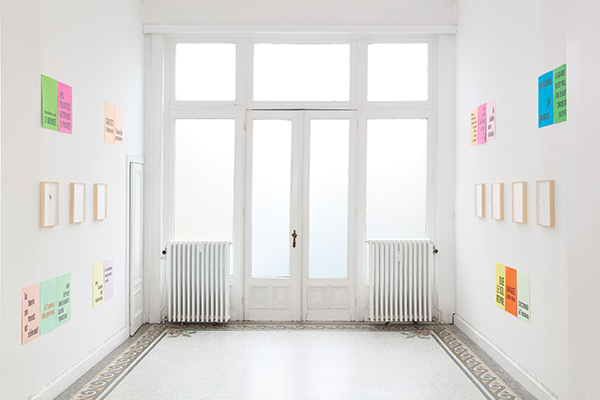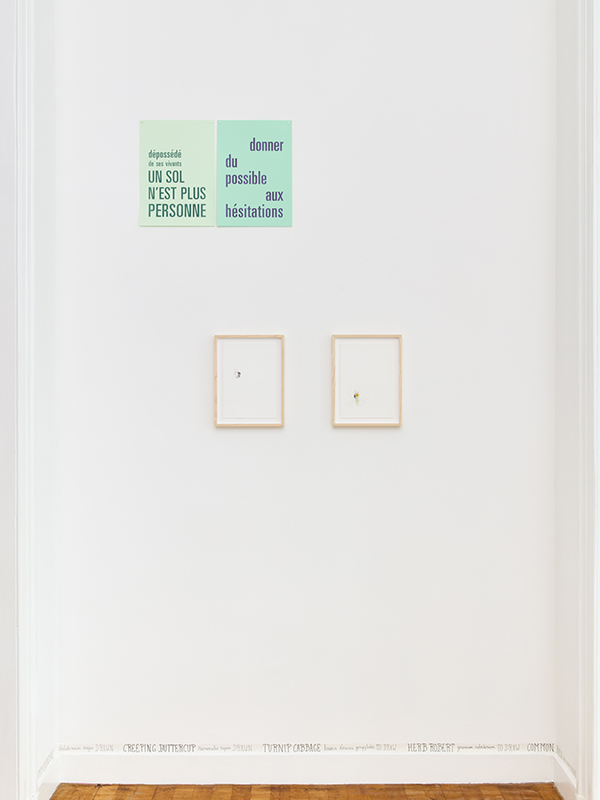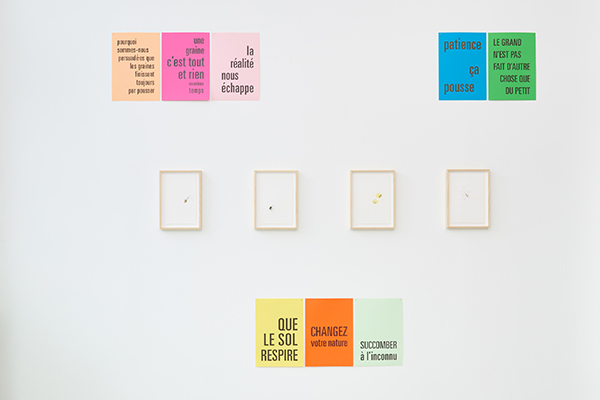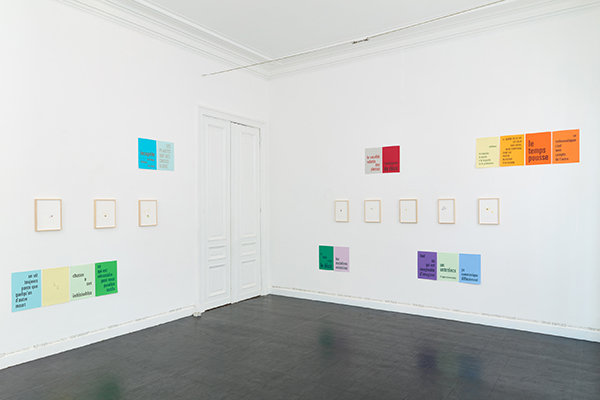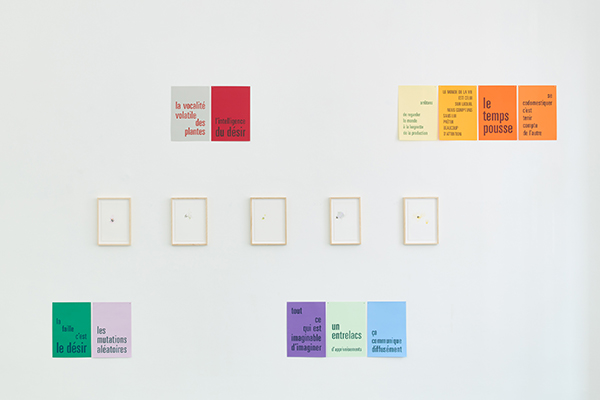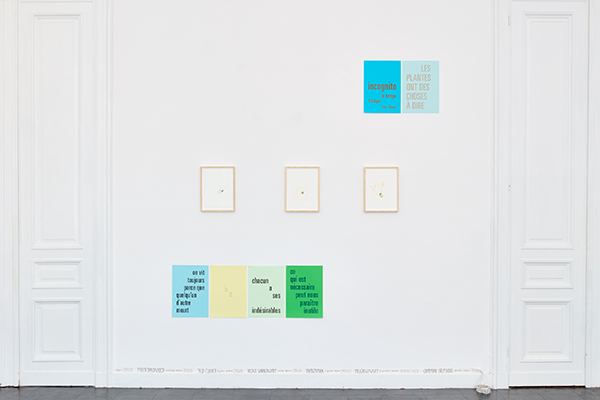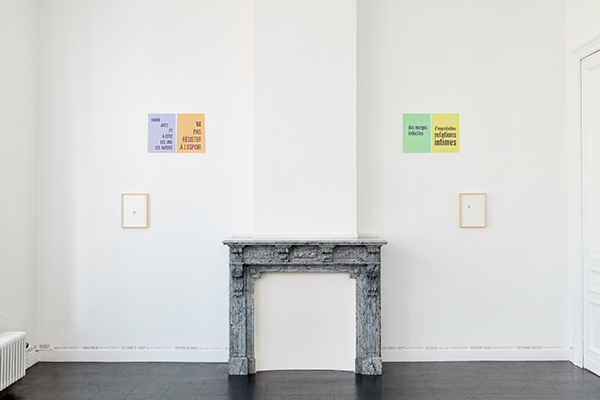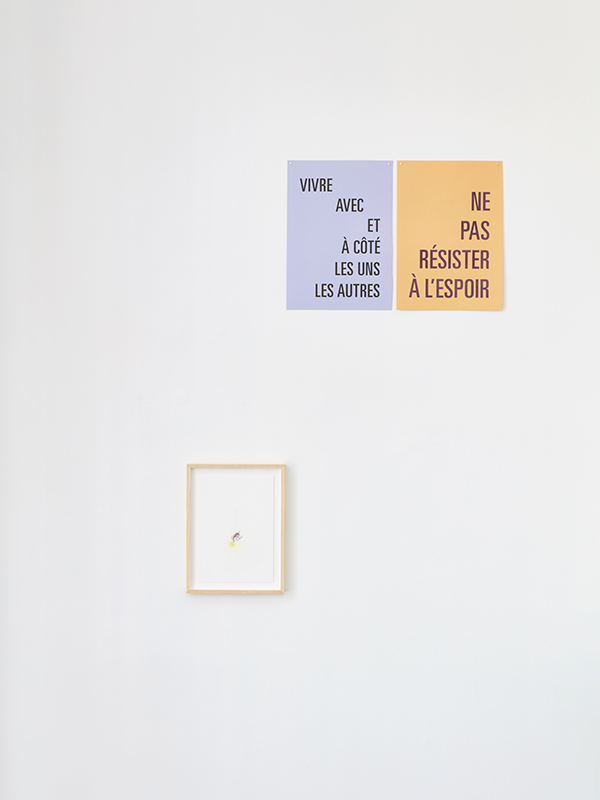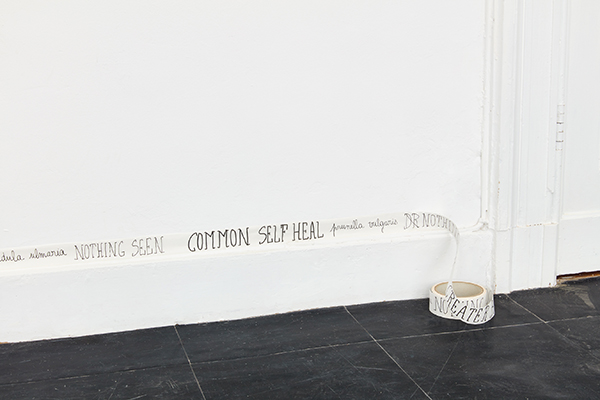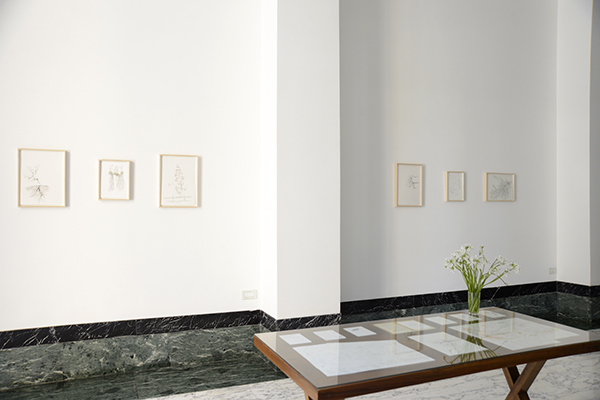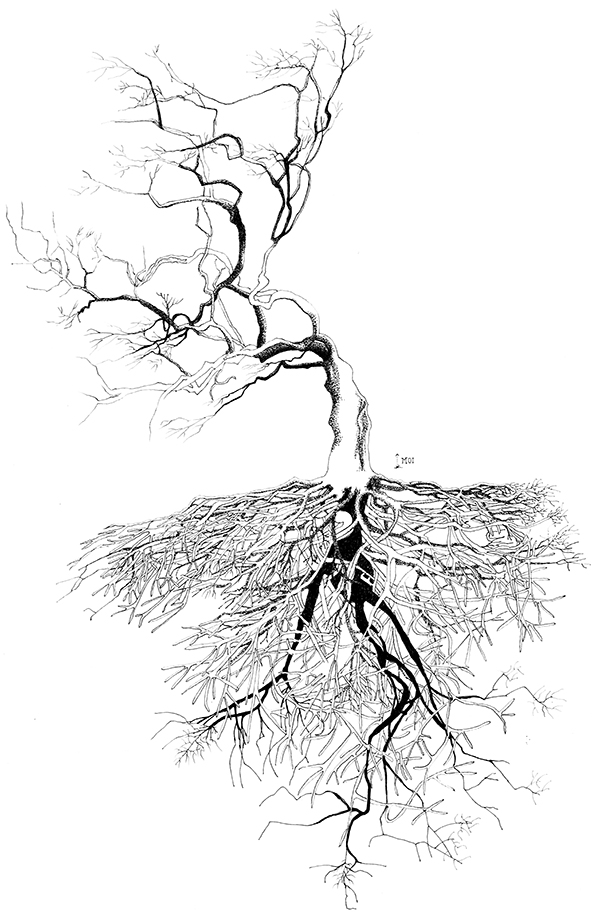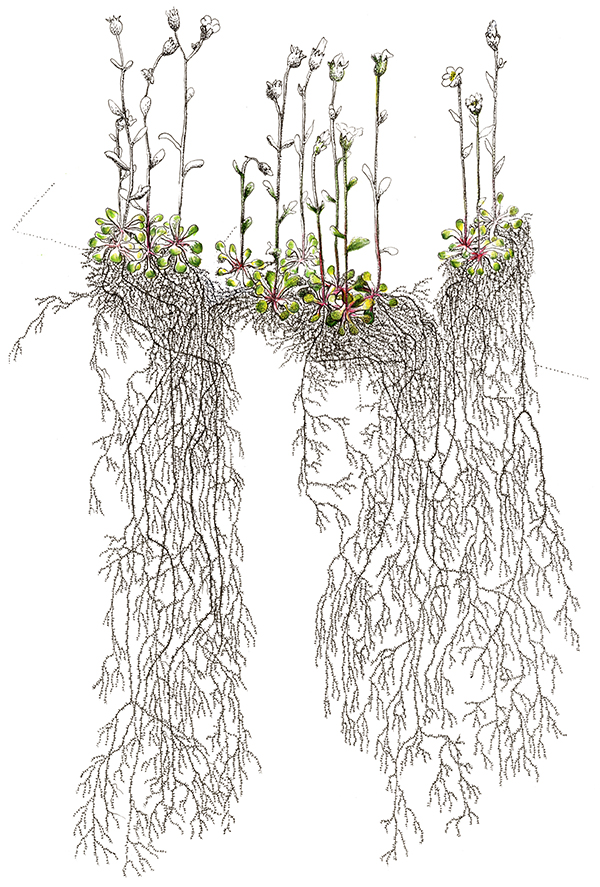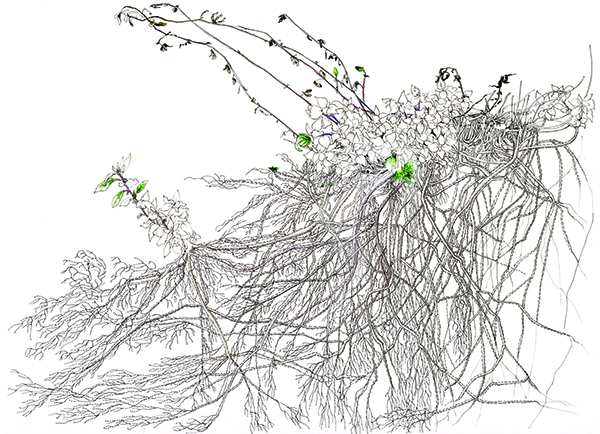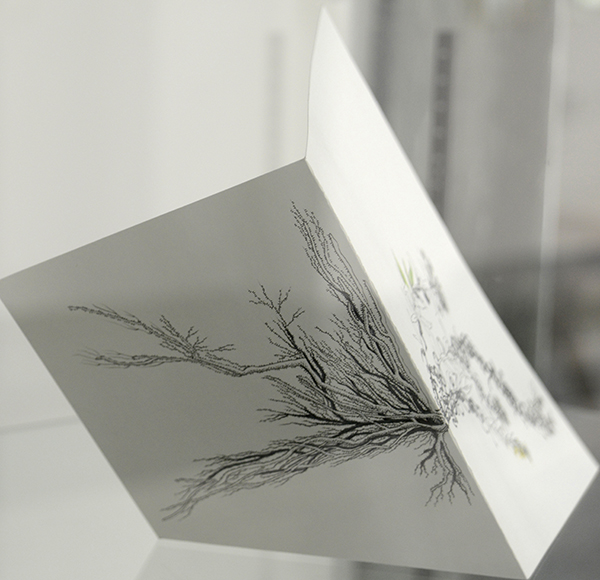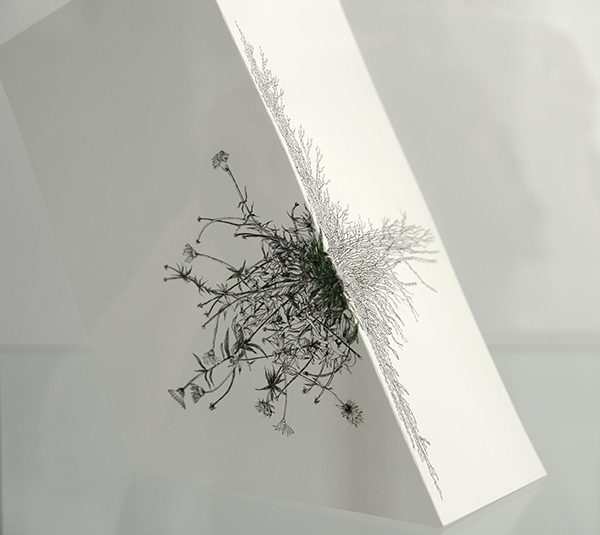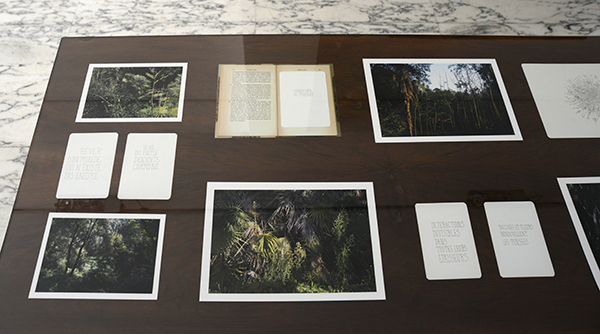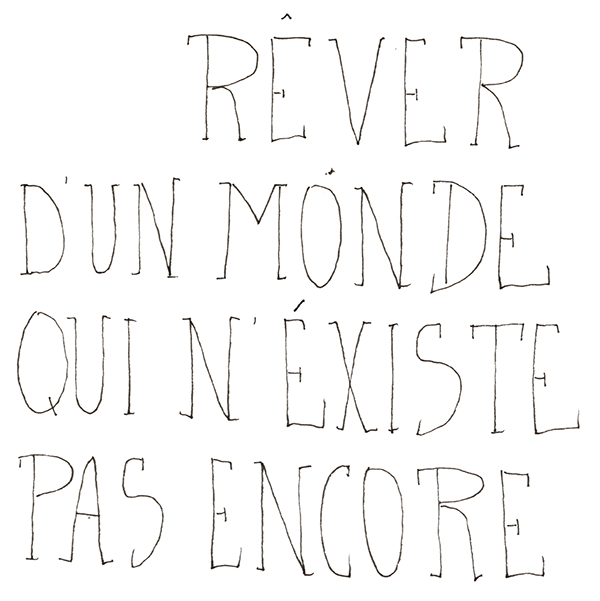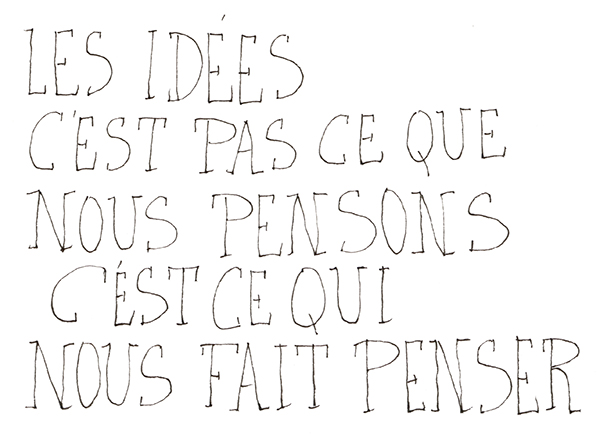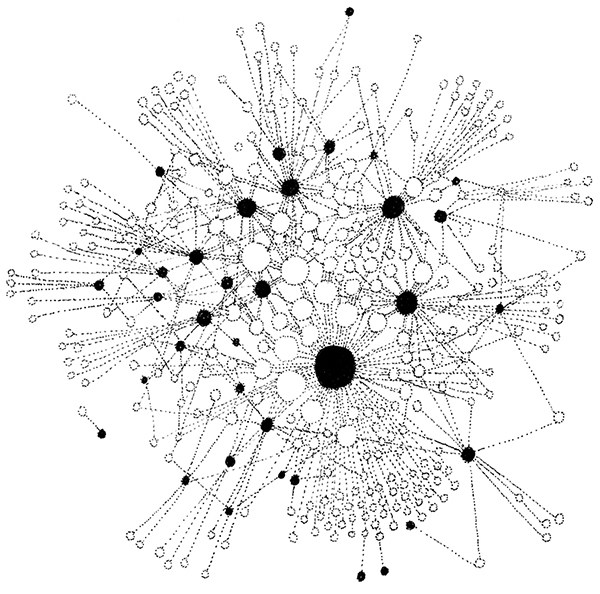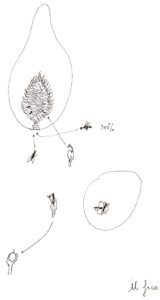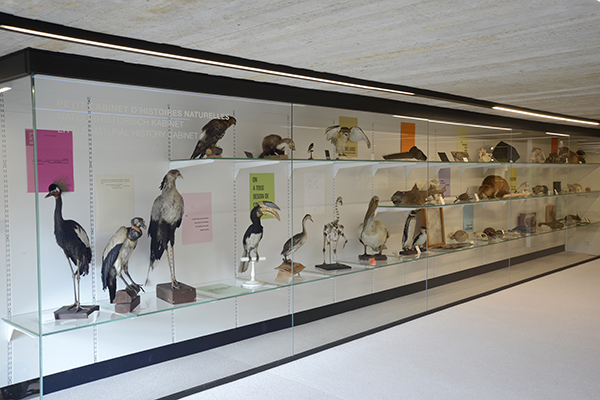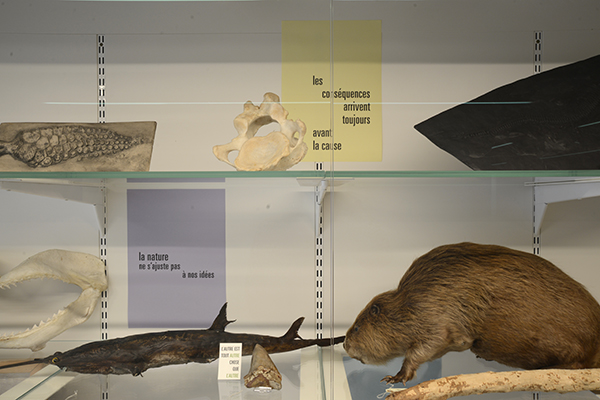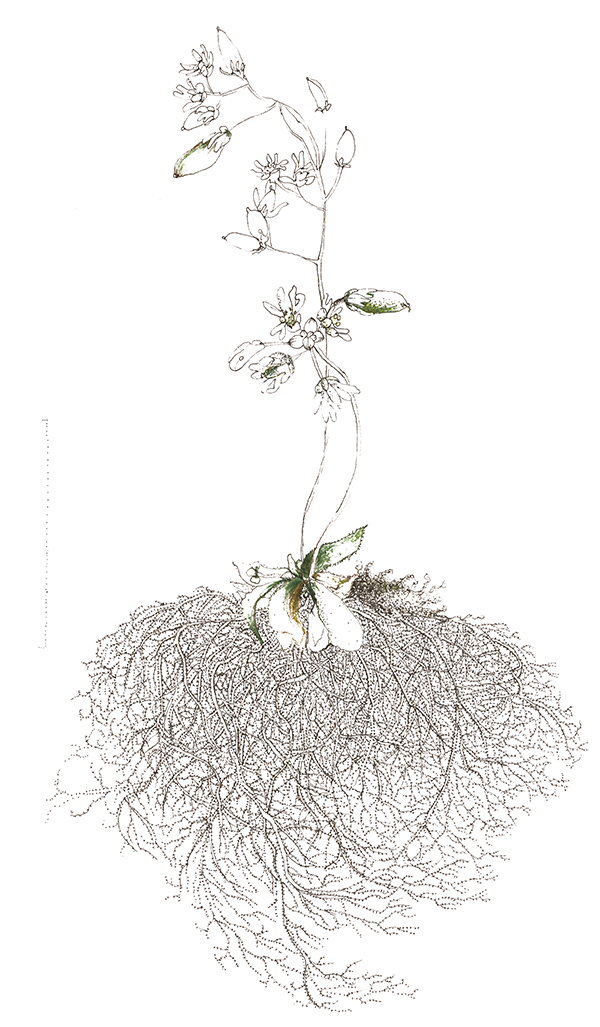les pensées submergées, Academia Belgica, Roma
solo exhibition 10 03 2022 - 08 04 2022
Often, the plants that grow spontaneously in the streets of big cities have become cosmopolitan. Are these strange familiar-aliens, frequently considered improper, invading us, or have we invaded them? To botanise, to take into account the others – who are nonhuman species – it is necessary to slow down, to walk around and to observe by small steps.
les pensées submergées (Submerged Thoughts) constitutes the second part of the book les errantes naturelles (Natural Wanderers). les errantes naturelles interweaves thoughts, botanical walks, drawings, and photographs around spontaneous street plants, enhanced with texts inspired by Lise Duclaux’s encounters with botanists and readings done by the artist during her residencies in New York in 2018 and Rome in winter 2020 and January 2021. Drowned by the flood of information, the thoughts became entangled around the impossibility of giving a clear representation of what is natural.
*
Souvent les plantes qui poussent spontanément dans les rues des grandes villes sont devenues cosmopolites. Ces étranges familières étrangères, fréquemment considérées comme impropres, nous envahissent-elles ou bien est-ce nous qui les avons envahies ? Pour herboriser, prendre en compte les autres – qui ne sont pas de notre espèce – il faut nécessairement ralentir, se promener et observer à petits pas.
les pensées submergées constituent la deuxième partie du livre les errantes naturelles. les errantes naturelles imbriquent des pensées, des promenades à herboriser, des dessins et des photographies autour des plantes spontanées des rues et rehaussées, de textes inspirés par les rencontres de Lise Duclaux avec des botanistes et des lectures réalisées par l’artiste lors de ses résidences à New York en 2018 et à Rome en hiver 2020 et janvier 2021. Noyées par les flots informations, les pensées s’enchevêtrent autour de l’impossibilité de donner une représentation claire de ce qui serait naturel.
Installation in situ, dessins, photographies, impressions digitales, livre d’artiste
Installation in situ, dessins, photographies, impressions digitales, livre d’artiste les errantes naturelles,
livres de la bibliothèque de l’Academia Belgica et ail de Naples cueilli sur une pente
aaaaaaaaaaaaaaaaaaaaaaaaaaaaaaaaaaaaaaaaaaaaaaaaaaaaaaaaaaaaaaaa
aaaaaaaaaaaaaaaaaaaaaaaaaaaaaaaaaaaaaaaaaaaaaaaaaaaaaaaaaaaaaaaa
aaaaaaaaaaaaaaaaaaaaaaaaaaaaaaaaaaaaaaaaaaaaaaaaaaaaaaaaaaaaaaaa
aaaaaaaaaaaaaaaaaaaaaaaaaaaaaaaaaaaaaaaaaaaaaaaaaaaaaaaaaaaaaaaa
aaaaaaaaaaaaaaaaaaaaaaaaaaaaaaaaaaaaaaaaaaaaaaaaaaaaaaaaaaaaaaaa
aaaaaaaaaaaaaaaaaaaaaaaaaaaaaaaaaaaaaaaaaaaaaaaaaaaaaaaaaaaaaaaa
monte aux cieux - Tree of heaven (Ailanthus altissima)
pigment ink on paper, 35 x 50 cm, 2020
An Asian that came to Italy for the breeding of silkworms, the ailanthus silkmoth. The production of silk failed, the butterfly and the tree acclimatised. Having become cosmopolitan, the tree lives in all large Western cities; it settles in disturbed, uncomfortable, polluted environments, poor – even stony – soils. In Rome, it likes roadsides, railroads, unbuildable slopes, and some walled slopes. It suckers freely, sprouting from the roots. The more it is cut, the more it rejects, a way to resist and survive. It is one of the signs of the transformation of landscapes and the appearance of new forms, new agreements to come.
*
Asiatique arrivé en Italie pour l’élevage du vers à soie : le bombyx de l’ailante. La production de soie a échoué, le papillon et l’arbre se sont acclimatés. Devenu cosmopolite, il vit notamment dans toutes les grandes villes occidentales, il s’installe dans des milieux perturbés, inconfortables, pollués, les sols pauvres même caillouteux. À Rome, il affectionne les bords de route, les voies ferrées, les pentes inconstructibles, et parfois quelques pentes emmurées. Il drageonne, s’installe par rejets partant des racines. Plus il est coupé, plus il rejette, une manière de résister et survivre. Il est un des signes de la transformation des paysages et de l’apparition de nouvelles formes, de nouvelles ententes à venir.
aaaaaaaaaaaaaaaaaaaaaaaaaaaaaaaaaaaaaaaaaaaaaaaaaaaaaaaaaaaaaaaa
aaaaaaaaaaaaaaaaaaaaaaaaaaaaaaaaaaaaaaaaaaaaaaaaaaaaaaaaaaaaaaaa
aaaaaaaaaaaaaaaaaaaaaaaaaaaaaaaaaaaaaaaaaaaaaaaaaaaaaaaaaaaaaaaa
aaaaaaaaaaaaaaaaaaaaaaaaaaaaaaaaaaaaaaaaaaaaaaaaaaaaaaaaaaaaaaaa
aaaaaaaaaaaaaaaaaaaaaaaaaaaaaaaaaaaaaaaaaaaaaaaaaaaaaaaaaaaaaaaa
aaaaaaaaaaaaaaaaaaaaaaaaaaaaaaaaaaaaaaaaaaaaaaaaaaaaaaaaaaaaaaaa
Câprier des murs - Flinders rose (Capparis spinosa)
pigment ink, coloured pencil and painting on paper, 29,7 x 21 cm, 2020
On top of a pillar in the centre of Rome, a Flinders rose has developed sufficient roots to fetch the water necessary for its survival. The Flinders rose, or caper, can be found everywhere, even in the centre of the city. It is a bush that frequents the old walls and sunny cliffs. Native to rocky shores, it has found in the walls and ruins of Rome the same conditions necessary for its survival as in the rocks of the seaside.
*
Câprier installé en haut d’un pilier au centre de Rome qui a développé des racines suffisantes pour aller chercher l’eau nécessaire à sa survie. Le câprier est un buisson qui fréquente les vieux murs et les falaises ensoleillées de Rome. Originaire des rivages rocheux, il a trouvé dans les murs et les ruines de Rome les mêmes conditions nécessaires à sa survie que dans les rochers des bords de mer. On le croise partout même en plein centre.
aaaaaaaaaaaaaaaaaaaaaaaaaaaaaaaaaaaaaaaaaaaaaaaaaaaaaaaaaaaaaaaa
aaaaaaaaaaaaaaaaaaaaaaaaaaaaaaaaaaaaaaaaaaaaaaaaaaaaaaaaaaaaaaaa
aaaaaaaaaaaaaaaaaaaaaaaaaaaaaaaaaaaaaaaaaaaaaaaaaaaaaaaaaaaaaaaa
aaaaaaaaaaaaaaaaaaaaaaaaaaaaaaaaaaaaaaaaaaaaaaaaaaaaaaaaaaaaaaaa
aaaaaaaaaaaaaaaaaaaaaaaaaaaaaaaaaaaaaaaaaaaaaaaaaaaaaaaaaaaaaaaa
aaaaaaaaaaaaaaaaaaaaaaaaaaaaaaaaaaaaaaaaaaaaaaaaaaaaaaaaaaaaaaaa
Nombril de venus et mouron des oiseaux
Navelwort and the nodding chickweed (Umbilicus rupestris)
pigment ink, coloured pencil and painting on paper, 29,7 x 21 cm, 2020
Spirit of the shaded wall, made for climbing, the Navelwort lives vertically. It is sometimes found on the bark of trees. Friend to insects, it moves thanks to them. It likes moisture and climbs little by little towards the north. The nodding chickweed lives everywhere - even in vegetable gardens - and in all positions.
*
Esprit des murs ombragés, taillés pour l’escalade, le nombril de venus vit à la verticale. On le rencontre parfois sur les écorces d’arbres. Ami des insectes, il se déplace grâce à eux. il aime l’humidité et monte petit à petit vers le nord. Le mouron des oiseaux, quant à lui, vit de partout même dans les jardins potagers et dans toutes les positions.
aaaaaaaaaaaaaaaaaaaaaaaaaaaaaaaaaaaaaaaaaaaaaaaaaaaaaaaaaaaaaaaa
aaaaaaaaaaaaaaaaaaaaaaaaaaaaaaaaaaaaaaaaaaaaaaaaaaaaaaaaaaaaaaaa
aaaaaaaaaaaaaaaaaaaaaaaaaaaaaaaaaaaaaaaaaaaaaaaaaaaaaaaaaaaaaaaa
aaaaaaaaaaaaaaaaaaaaaaaaaaaaaaaaaaaaaaaaaaaaaaaaaaaaaaaaaaaaaaaa
aaaaaaaaaaaaaaaaaaaaaaaaaaaaaaaaaaaaaaaaaaaaaaaaaaaaaaaaaaaaaaaa
aaaaaaaaaaaaaaaaaaaaaaaaaaaaaaaaaaaaaaaaaaaaaaaaaaaaaaaaaaaaaaaa
Ce vieil étranger le platane et moi
This old foreigner, the Old-World sycamore and me (Platanus orientalis)
pigment ink on paper, 42 x 29,7 cm, 2021
Oriental plane tree, more than 400 years old, living in the plane trees valley of the Villa Borghese park, naturalised but now rare, it was considered a foreign species imported at the ancient Greek and Roman times for the quality of its shade (cf. Pliny the Elder). The tree has lived through part of the history of Rome and knows a great deal about what goes on underground. What is a human life compared to the life of a tree?
*
Platane d’orient âgé de plus de 400 ans, vivant dans la vallée des platanes du parc de la Villa Borghese, naturalisé mais devenu rare, il était considéré comme une espèce étrangère importée au temps des Grecs et des Romains pour la qualité de son ombrage (cf. Pline l’Ancien). Il a vécu une partie de l’histoire de Rome et en connaît long sur ce qui se passe sous terre. Qu’est-ce qu’une vie humaine en comparaison avec la vie d’un arbre ?
aaaaaaaaaaaaaaaaaaaaaaaaaaaaaaaaaaaaaaaaaaaaaaaaaaaaaaaaaaaaaaaa
aaaaaaaaaaaaaaaaaaaaaaaaaaaaaaaaaaaaaaaaaaaaaaaaaaaaaaaaaaaaaaaa
aaaaaaaaaaaaaaaaaaaaaaaaaaaaaaaaaaaaaaaaaaaaaaaaaaaaaaaaaaaaaaaa
aaaaaaaaaaaaaaaaaaaaaaaaaaaaaaaaaaaaaaaaaaaaaaaaaaaaaaaaaaaaaaaa
aaaaaaaaaaaaaaaaaaaaaaaaaaaaaaaaaaaaaaaaaaaaaaaaaaaaaaaaaaaaaaaa
aaaaaaaaaaaaaaaaaaaaaaaaaaaaaaaaaaaaaaaaaaaaaaaaaaaaaaaaaaaaaaaa
Saxifrage à trois doigts - Rue-leaved saxifrage (Saxifraga tridactylites)
pigment ink and coloured pencil and painting on paper, 29,7 x 21 cm, 2020 - 2021
Spirit of the walls, mountains, cliffs and dunes, a pioneer rarely exceeding 10 cm, made for climbing, a stealthy and seasonal plant that blooms at the dawn of spring, it is considered a miner, a stone drill, although no building has yet collapsed because of it. It promotes the accumulation of humus and substrate by dying and allow other, more demanding species to settle after it.
*
Esprit des murs, des montagnes des dunes et des falaises, pionnière dépassant rarement 10 cm, taillés pour l’escalade, furtive et saisonnière qui fleurit à l’orée du printemps, elle est considérée comme une mineuse, perceuse de pierre, bien qu’aucun édifice ne se soit écroulé à cause d’elle. Elles favorisent l’accumulation d’humus et de substrat en mourant et permettent à d’autres espèces plus exigeantes de s’installer derrière elles.
aaaaaaaaaaaaaaaaaaaaaaaaaaaaaaaaaaaaaaaaaaaaaaaaaaaaaaaaaaaaaaaa
aaaaaaaaaaaaaaaaaaaaaaaaaaaaaaaaaaaaaaaaaaaaaaaaaaaaaaaaaaaaaaaa
aaaaaaaaaaaaaaaaaaaaaaaaaaaaaaaaaaaaaaaaaaaaaaaaaaaaaaaaaaaaaaaa
aaaaaaaaaaaaaaaaaaaaaaaaaaaaaaaaaaaaaaaaaaaaaaaaaaaaaaaaaaaaaaaa
aaaaaaaaaaaaaaaaaaaaaaaaaaaaaaaaaaaaaaaaaaaaaaaaaaaaaaaaaaaaaaaa
aaaaaaaaaaaaaaaaaaaaaaaaaaaaaaaaaaaaaaaaaaaaaaaaaaaaaaaaaaaaaaaa
Ortie douteuse - Membranous nettle (Urtica membranacea)
pigment ink and coloured pencil on paper, 42 x 29,7 cm, 2020
The membranous nettle is specifically a Mediterranean species. It likes the morning dew, appears in the streets of Rome in mid-autumn and disappears in the heat of summer. It is a recurrent transient, ephemeral like most of the flora of the sidewalks. One comes across them from time to time in Belgium.
*
L’ortie douteuse est une espèce spécifiquement méditerranéenne. Elle affectionne la rosée du matin, apparaît dans les rues de Rome à la mi-automne et disparaît à la chaleur de l’été. C’est une récurrente passagère, éphémère comme la plupart de la flore des trottoirs. On croise de temps en temps quelques individus en Belgique.
aaaaaaaaaaaaaaaaaaaaaaaaaaaaaaaaaaaaaaaaaaaaaaaaaaaaaaaaaaaaaaaa
aaaaaaaaaaaaaaaaaaaaaaaaaaaaaaaaaaaaaaaaaaaaaaaaaaaaaaaaaaaaaaaa
aaaaaaaaaaaaaaaaaaaaaaaaaaaaaaaaaaaaaaaaaaaaaaaaaaaaaaaaaaaaaaaa
aaaaaaaaaaaaaaaaaaaaaaaaaaaaaaaaaaaaaaaaaaaaaaaaaaaaaaaaaaaaaaaa
aaaaaaaaaaaaaaaaaaaaaaaaaaaaaaaaaaaaaaaaaaaaaaaaaaaaaaaaaaaaaaaa
aaaaaaaaaaaaaaaaaaaaaaaaaaaaaaaaaaaaaaaaaaaaaaaaaaaaaaaaaaaaaaaa
Ruine de Rome - Coliseum ivy (Cymbalaria muralis)
pigment ink drawing, coloured pencil, and painting on paper, 42 x 29,7 cm, 2020
Harmless cosmopolitan that appreciates the old stones. It can be found along and on walls throughout Europe. Introduced 500 years ago from Italy, it has been cherished for centuries in the gardens of castles.
*
Inoffensive cosmopolite qui apprécie les vieilles pierres. On la rencontre le long et sur les murs dans toute l’Europe. Introduite il y a 500 ans depuis l’Italie, elle a été choyée pendant des siècles dans les jardins des châteaux.
aaaaaaaaaaaaaaaaaaaaaaaaaaaaaaaaaaaaaaaaaaaaaaaaaaaaaaaaaaaaaaaa
aaaaaaaaaaaaaaaaaaaaaaaaaaaaaaaaaaaaaaaaaaaaaaaaaaaaaaaaaaaaaaaa
aaaaaaaaaaaaaaaaaaaaaaaaaaaaaaaaaaaaaaaaaaaaaaaaaaaaaaaaaaaaaaaa
aaaaaaaaaaaaaaaaaaaaaaaaaaaaaaaaaaaaaaaaaaaaaaaaaaaaaaaaaaaaaaaa
aaaaaaaaaaaaaaaaaaaaaaaaaaaaaaaaaaaaaaaaaaaaaaaaaaaaaaaaaaaaaaaa
aaaaaaaaaaaaaaaaaaaaaaaaaaaaaaaaaaaaaaaaaaaaaaaaaaaaaaaaaaaaaaaa
Dissémination de la ruine de rome et de l’impatiente de l’Himalaya
Dissemination of Coliseum ivy and Himalayan balsam
pigment ink on paper, 21 x 29,7 cm, 2021
Coliseum ivy moves from gap to gap. It climbs by lengthening its stem to deposit its seeds in the crevices of the walls. To spread out, Himalayan balsam explodes its fruit at maturity and throws its seeds far and wide. No Himalayan balsam has been found in Rome.
*
La ruine de Rome se déplace d’interstice en interstice. Elle grimpe en allongeant sa tige pour déposer d’elle-même ses graines dans les anfractuosités des murs. L’impatiente de l’Himalaya fait exploser son fruit à maturité et projette ses graines au loin pour se disperser. Aucune impatiente n’a été rencontrée à Rome.
aaaaaaaaaaaaaaaaaaaaaaaaaaaaaaaaaaaaaaaaaaaaaaaaaaaaaaaaaaaaaaaa
aaaaaaaaaaaaaaaaaaaaaaaaaaaaaaaaaaaaaaaaaaaaaaaaaaaaaaaaaaaaaaaa
aaaaaaaaaaaaaaaaaaaaaaaaaaaaaaaaaaaaaaaaaaaaaaaaaaaaaaaaaaaaaaaa
aaaaaaaaaaaaaaaaaaaaaaaaaaaaaaaaaaaaaaaaaaaaaaaaaaaaaaaaaaaaaaaa
aaaaaaaaaaaaaaaaaaaaaaaaaaaaaaaaaaaaaaaaaaaaaaaaaaaaaaaaaaaaaaaa
aaaaaaaaaaaaaaaaaaaaaaaaaaaaaaaaaaaaaaaaaaaaaaaaaaaaaaaaaaaaaaaa
Casse pierre, pariétaire - Pellitory-of-the-wall (Parietaria judaica)
pigment ink, coloured pencil, and painting on paper, 29,7 x 42 cm, 2020 - 2021
Spirit of the caves and Mediterranean walls, present on earth since prehistoric times, it is the witness of change in the world. Unloved, green in winter, grey and dusty at the end of spring, it can be found on all old walls and cliffs. Friend to insects and birds, it has accompanied us for a long time. It goes on the offensive and tries to settle in Belgium.
*
Esprit des grottes et des murs méditerranéen, présente sur terre depuis la préhistoire, elle est le témoin des changements du monde. Mal aimée, verte en hiver, grise et poussiéreuse dès la fin du printemps, on la croise sur tous les vieux murs et les falaises. Amie des oiseaux et des insectes, elle nous accompagne depuis longtemps. Elle monte à l’assaut et tente de s’installer en Belgique.
aaaaaaaaaaaaaaaaaaaaaaaaaaaaaaaaaaaaaaaaaaaaaaaaaaaaaaaaaaaaaaaa
aaaaaaaaaaaaaaaaaaaaaaaaaaaaaaaaaaaaaaaaaaaaaaaaaaaaaaaaaaaaaaaaaaaaaaaaaaaaaaaaaaaaaaaaaaaaaaaaaaaaaaaaaaaaaaaaaaaaaaaaaaaaaaaa
aaaaaaaaaaaaaaaaaaaaaaaaaaaaaaaaaaaaaaaaaaaaaaaaaaaaaaaaaaaaaaaa
aaaaaaaaaaaaaaaaaaaaaaaaaaaaaaaaaaaaaaaaaaaaaaaaaaaaaaaaaaaaaaaa
aaaaaaaaaaaaaaaaaaaaaaaaaaaaaaaaaaaaaaaaaaaaaaaaaaaaaaaaaaaaaaaa
Les ententes communes - Common agreements
The spirit of walls, of sloping walls, walled slopes, and ruins
Climbing plants like humanised spaces and can withstand extreme conditions and wide variations in temperature.
L’esprit des murs, des murs en pentes, des pentes emmurées et des ruines
Les plantes à l’assaut des murs aiment les espaces humanisés, et supportent des conditions extrêmes et d’importantes variations de température.
*
Elucidations of the sidewalks
In the cracks of the sidewalks, along the walls, the spontaneous plants of the streets are recurring, transient, furtive, and seasonal. The street is a redundant space favourable to trampling; to settle there for any length of time is risky; most are ephemeral.
L’élucubration des trottoirs
Dans les fissures des trottoirs, le long des murs, les plantes spontanées des rues sont de récurrentes passagères, furtives et saisonnières. La rue est un espace redoutable propice aux piétinements, s’y installer dans la durée est risqué, la plupart sont éphémères.
dessins, photographies, livre d’artiste les errantes naturelles
aaaaaaaaaaaaaaaaaaaaaaaaaaaaaaaaaaaaaaaaaaaaaaaaaaaaaaaaaaaaaaaa
aaaaaaaaaaaaaaaaaaaaaaaaaaaaaaaaaaaaaaaaaaaaaaaaaaaaaaaaaaaaaaaa
aaaaaaaaaaaaaaaaaaaaaaaaaaaaaaaaaaaaaaaaaaaaaaaaaaaaaaaaaaaaaaaa
aaaaaaaaaaaaaaaaaaaaaaaaaaaaaaaaaaaaaaaaaaaaaaaaaaaaaaaaaaaaaaaa
aaaaaaaaaaaaaaaaaaaaaaaaaaaaaaaaaaaaaaaaaaaaaaaaaaaaaaaaaaaaaaaa
aaaaaaaaaaaaaaaaaaaaaaaaaaaaaaaaaaaaaaaaaaaaaaaaaaaaaaaaaaaaaaaa
quand deux substances
pigment ink on paper, 15 x 10,5 cm, 2020
aaaaaaaaaaaaaaaaaaaaaaaaaaaaaaaaaaaaaaaaaaaaaaaaaaaaaaaaaaaaaaaa
aaaaaaaaaaaaaaaaaaaaaaaaaaaaaaaaaaaaaaaaaaaaaaaaaaaaaaaaaaaaaaaa
aaaaaaaaaaaaaaaaaaaaaaaaaaaaaaaaaaaaaaaaaaaaaaaaaaaaaaaaaaaaaaaa
aaaaaaaaaaaaaaaaaaaaaaaaaaaaaaaaaaaaaaaaaaaaaaaaaaaaaaaaaaaaaaaa
aaaaaaaaaaaaaaaaaaaaaaaaaaaaaaaaaaaaaaaaaaaaaaaaaaaaaaaaaaaaaaaa
aaaaaaaaaaaaaaaaaaaaaaaaaaaaaaaaaaaaaaaaaaaaaaaaaaaaaaaaaaaaaaaa
inule visqueuse (Dittrichia viscosa)
pigment ink, coloured pencil, and painting on paper, 2020 - 2021
aaaaaaaaaaaaaaaaaaaaaaaaaaaaaaaaaaaaaaaaaaaaaaaaaaaaaaaaaaaaaaaa
aaaaaaaaaaaaaaaaaaaaaaaaaaaaaaaaaaaaaaaaaaaaaaaaaaaaaaaaaaaaaaaa
aaaaaaaaaaaaaaaaaaaaaaaaaaaaaaaaaaaaaaaaaaaaaaaaaaaaaaaaaaaaaaaa
aaaaaaaaaaaaaaaaaaaaaaaaaaaaaaaaaaaaaaaaaaaaaaaaaaaaaaaaaaaaaaaa
aaaaaaaaaaaaaaaaaaaaaaaaaaaaaaaaaaaaaaaaaaaaaaaaaaaaaaaaaaaaaaaa
aaaaaaaaaaaaaaaaaaaaaaaaaaaaaaaaaaaaaaaaaaaaaaaaaaaaaaaaaaaaaaaa
pâquerette mexicaine (Erigeron karvinskianus)
pigment ink, coloured pencil, and painting on paper, 2020 - 2021
aaaaaaaaaaaaaaaaaaaaaaaaaaaaaaaaaaaaaaaaaaaaaaaaaaaaaaaaaaaaaaaa
aaaaaaaaaaaaaaaaaaaaaaaaaaaaaaaaaaaaaaaaaaaaaaaaaaaaaaaaaaaaaaaa
aaaaaaaaaaaaaaaaaaaaaaaaaaaaaaaaaaaaaaaaaaaaaaaaaaaaaaaaaaaaaaaa
aaaaaaaaaaaaaaaaaaaaaaaaaaaaaaaaaaaaaaaaaaaaaaaaaaaaaaaaaaaaaaaa
aaaaaaaaaaaaaaaaaaaaaaaaaaaaaaaaaaaaaaaaaaaaaaaaaaaaaaaaaaaaaaaa
aaaaaaaaaaaaaaaaaaaaaaaaaaaaaaaaaaaaaaaaaaaaaaaaaaaaaaaaaaaaaaaa
Les ententes communes - Common agreements
Forms of woodland thoughts - Formes de pensées sylvestres
On unbuildable slopes, steep escarpments, and sloping groves, a multitude of plants settle in according to the circulation of water, wind, rain, and the animals that inhabit or fly over them. A space where species become naturalised, where evolution and information exchange can take place freely, where spontaneous aliens rub shoulders with natives, where domesticated plants coexist with their wild plants, where the dying will be spontaneously replaced by other specimens. New landscapes in the making are created, new agreements are possible.
*
Dans les pentes inconstructibles, les escarpements escarpés, les bosquets en pente, une multitude de plantes s’installent au gré de la circulation de l’eau, des vents, des pluies, et des animaux qui les habitent ou les survolent. Espace où les espèces se naturalisent, où l’évolution, les échanges d’informations, peuvent se réaliser en toutes libertés, où les exotiques spontanées côtoient les indigènes, où les plantées domestiquées s’acoquinent avec les sauvageonnes, où les moribondes seront remplacées spontanément par d’autres. De nouveaux paysages en devenir se créent, de nouvelles ententes sont possibles.
dessins, photographies, impressions digitales d’une page d’un livre de la bibliothèque de l’Academia Belgica : Pline l’Ancien, Histoire naturelle, livres XIII
aaaaaaaaaaaaaaaaaaaaaaaaaaaaaaaaaaaaaaaaaaaaaaaaaaaaaaaaaaaaaaaa
aaaaaaaaaaaaaaaaaaaaaaaaaaaaaaaaaaaaaaaaaaaaaaaaaaaaaaaaaaaaaaaa
aaaaaaaaaaaaaaaaaaaaaaaaaaaaaaaaaaaaaaaaaaaaaaaaaaaaaaaaaaaaaaaa
aaaaaaaaaaaaaaaaaaaaaaaaaaaaaaaaaaaaaaaaaaaaaaaaaaaaaaaaaaaaaaaa
aaaaaaaaaaaaaaaaaaaaaaaaaaaaaaaaaaaaaaaaaaaaaaaaaaaaaaaaaaaaaaaa
aaaaaaaaaaaaaaaaaaaaaaaaaaaaaaaaaaaaaaaaaaaaaaaaaaaaaaaaaaaaaaaa
rêver d’un monde qui n’existe pas encore
pigment ink on paper, 15 x 10,5 cm, 2020
aaaaaaaaaaaaaaaaaaaaaaaaaaaaaaaaaaaaaaaaaaaaaaaaaaaaaaaaaaaaaaaa
aaaaaaaaaaaaaaaaaaaaaaaaaaaaaaaaaaaaaaaaaaaaaaaaaaaaaaaaaaaaaaaa
aaaaaaaaaaaaaaaaaaaaaaaaaaaaaaaaaaaaaaaaaaaaaaaaaaaaaaaaaaaaaaaa
aaaaaaaaaaaaaaaaaaaaaaaaaaaaaaaaaaaaaaaaaaaaaaaaaaaaaaaaaaaaaaaa
aaaaaaaaaaaaaaaaaaaaaaaaaaaaaaaaaaaaaaaaaaaaaaaaaaaaaaaaaaaaaaaa
aaaaaaaaaaaaaaaaaaaaaaaaaaaaaaaaaaaaaaaaaaaaaaaaaaaaaaaaaaaaaaaa
Palmiers et montes aux cieux, Rome
photographie couleurs, 20 x 30 cm, 2020 - 2022
des larves de papillons et de coléoptères venues de lointains pays mangent les vieux palmiers étrangers jusqu’à les faire dépérir, les montes aux cieux commencent à prendre leur place les formes changent et nous annoncent les futurs changements de forme du monde
aaaaaaaaaaaaaaaaaaaaaaaaaaaaaaaaaaaaaaaaaaaaaaaaaaaaaaaaaaaaaaaa
aaaaaaaaaaaaaaaaaaaaaaaaaaaaaaaaaaaaaaaaaaaaaaaaaaaaaaaaaaaaaaaa
aaaaaaaaaaaaaaaaaaaaaaaaaaaaaaaaaaaaaaaaaaaaaaaaaaaaaaaaaaaaaaaa
aaaaaaaaaaaaaaaaaaaaaaaaaaaaaaaaaaaaaaaaaaaaaaaaaaaaaaaaaaaaaaaa
aaaaaaaaaaaaaaaaaaaaaaaaaaaaaaaaaaaaaaaaaaaaaaaaaaaaaaaaaaaaaaaa
aaaaaaaaaaaaaaaaaaaaaaaaaaaaaaaaaaaaaaaaaaaaaaaaaaaaaaaaaaaaaaaa
Forms of woodland thoughts - Formes de pensées sylvestres
dessins, photographies, impressions digitales d’une page d’un livre de la bibliothèque de l’Academia Belgica : Lucrèce, De la Nature, et ail de Naples cueilli sur une pente
aaaaaaaaaaaaaaaaaaaaaaaaaaaaaaaaaaaaaaaaaaaaaaaaaaaaaaaaaaaaaaaa
aaaaaaaaaaaaaaaaaaaaaaaaaaaaaaaaaaaaaaaaaaaaaaaaaaaaaaaaaaaaaaaa
aaaaaaaaaaaaaaaaaaaaaaaaaaaaaaaaaaaaaaaaaaaaaaaaaaaaaaaaaaaaaaaa
aaaaaaaaaaaaaaaaaaaaaaaaaaaaaaaaaaaaaaaaaaaaaaaaaaaaaaaaaaaaaaaa
aaaaaaaaaaaaaaaaaaaaaaaaaaaaaaaaaaaaaaaaaaaaaaaaaaaaaaaaaaaaaaaa
aaaaaaaaaaaaaaaaaaaaaaaaaaaaaaaaaaaaaaaaaaaaaaaaaaaaaaaaaaaaaaaa
les idées c’est pas ce que nous pensons c’est ce qui nous fait penser
pigment ink on paper, 15 x 10,5 cm, 2021
aaaaaaaaaaaaaaaaaaaaaaaaaaaaaaaaaaaaaaaaaaaaaaaaaaaaaaaaaaaaaaaa
aaaaaaaaaaaaaaaaaaaaaaaaaaaaaaaaaaaaaaaaaaaaaaaaaaaaaaaaaaaaaaaa
aaaaaaaaaaaaaaaaaaaaaaaaaaaaaaaaaaaaaaaaaaaaaaaaaaaaaaaaaaaaaaaa
aaaaaaaaaaaaaaaaaaaaaaaaaaaaaaaaaaaaaaaaaaaaaaaaaaaaaaaaaaaaaaaa
aaaaaaaaaaaaaaaaaaaaaaaaaaaaaaaaaaaaaaaaaaaaaaaaaaaaaaaaaaaaaaaa
aaaaaaaaaaaaaaaaaaaaaaaaaaaaaaaaaaaaaaaaaaaaaaaaaaaaaaaaaaaaaaaa
formes émergentes de pensées sylvestres 03, bosquet viale delle belle arti, Rome
digital print, pigment ink, coloured pencil, marker, tapes, on paper, 48,2 x 42 cm, 2020
aaaaaaaaaaaaaaaaaaaaaaaaaaaaaaaaaaaaaaaaaaaaaaaaaaaaaaaaaaaaaaaa
aaaaaaaaaaaaaaaaaaaaaaaaaaaaaaaaaaaaaaaaaaaaaaaaaaaaaaaaaaaaaaaa
aaaaaaaaaaaaaaaaaaaaaaaaaaaaaaaaaaaaaaaaaaaaaaaaaaaaaaaaaaaaaaaa
aaaaaaaaaaaaaaaaaaaaaaaaaaaaaaaaaaaaaaaaaaaaaaaaaaaaaaaaaaaaaaaa
aaaaaaaaaaaaaaaaaaaaaaaaaaaaaaaaaaaaaaaaaaaaaaaaaaaaaaaaaaaaaaaa
aaaaaaaaaaaaaaaaaaaaaaaaaaaaaaaaaaaaaaaaaaaaaaaaaaaaaaaaaaaaaaaa
idée d’un réseau de plantes et champignons
(en région tempérée froide), 29,7 x 21 cm, 2020
aaaaaaaaaaaaaaaaaaaaaaaaaaaaaaaaaaaaaaaaaaaaaaaaaaaaaaaaaaaaaaaa
aaaaaaaaaaaaaaaaaaaaaaaaaaaaaaaaaaaaaaaaaaaaaaaaaaaaaaaaaaaaaaaa
aaaaaaaaaaaaaaaaaaaaaaaaaaaaaaaaaaaaaaaaaaaaaaaaaaaaaaaaaaaaaaaa
aaaaaaaaaaaaaaaaaaaaaaaaaaaaaaaaaaaaaaaaaaaaaaaaaaaaaaaaaaaaaaaa
aaaaaaaaaaaaaaaaaaaaaaaaaaaaaaaaaaaaaaaaaaaaaaaaaaaaaaaaaaaaaaaa
aaaaaaaaaaaaaaaaaaaaaaaaaaaaaaaaaaaaaaaaaaaaaaaaaaaaaaaaaaaaaaaa
Les ententes communes - Common agreements
Les pensées émergentes des rives - Thoughts emerging from the banks
A few days of rain each winter are enough for the Tiber to flood. The current drains a multitude of waste: leaves, twigs, branches, fruit, seeds, paper, plastic, fabric. The ensemble mingles glued together by silt, clings to the plants and branches of the trees and forms small sculptures.
When the water level drops, the silt is deposited on the banks and in the gaps of the borders, offering possibilities for spontaneity; it allows seeds to germinate and transform the surroundings by growing. Like the fig tree, a spontaneous and cultivated Mediterranean tree, or the Spanish plane tree, an ornamental allee tree – a 17th-century cross between the oriental and American plane trees – which, after more than 200 years, has become spontaneous and settled on the banks.
*
Quelques jours de pluie suffisent chaque hiver pour que le Tibre soit en crue. Le courant draine une multitude de déchets: feuilles, brindilles, branches, fruits, graines, papiers, plastiques, tissus. L’ensemble collé par le limon se mélange, s’accroche aux plantes, aux branches des arbres et forme de petites sculptures.
À la décrue le limon se dépose sur les berges et dans les interstices des bordures, il offre des possibles à la spontanéité, il permet aux graines de germer et en poussant de transformer les abords. Comme le figuier arbre méditerranéen sauvage et cultivé ou le Platane d’Espagne, arbre d’ornement bordant les allées des rues – croisement réalisé au 17e siècle entre le platane d’orient et le platane d’Amérique – qui après plus de 200 ans est devenu spontané et s’installe sur les rives.
dessins, photographies, livre d’artiste : les errantes naturelles, livres de l’Academia Belgica :Pline l’Ancien, Histoire naturelle, livres XII et XVI, Théophraste, Les Causes de phénomènes végétaux
aaaaaaaaaaaaaaaaaaaaaaaaaaaaaaaaaaaaaaaaaaaaaaaaaaaaaaaaaaaaaaaa
aaaaaaaaaaaaaaaaaaaaaaaaaaaaaaaaaaaaaaaaaaaaaaaaaaaaaaaaaaaaaaaa
aaaaaaaaaaaaaaaaaaaaaaaaaaaaaaaaaaaaaaaaaaaaaaaaaaaaaaaaaaaaaaaa
aaaaaaaaaaaaaaaaaaaaaaaaaaaaaaaaaaaaaaaaaaaaaaaaaaaaaaaaaaaaaaaa
aaaaaaaaaaaaaaaaaaaaaaaaaaaaaaaaaaaaaaaaaaaaaaaaaaaaaaaaaaaaaaaa
aaaaaaaaaaaaaaaaaaaaaaaaaaaaaaaaaaaaaaaaaaaaaaaaaaaaaaaaaaaaaaaa
aaaaaaaaaaaaaaaaaaaaaaaaaaaaaaaaaaaaaaaaaaaaaaaaaaaaaaaaaaaaaaaa
fleurs de figues et son pollinisateur, pollinisation de l’inflorescence creuse d’une figue, naissance d’une figue mûre,
pigment ink and coloured pencil on paper, 3x 15 x 10,5 cm, 2020
